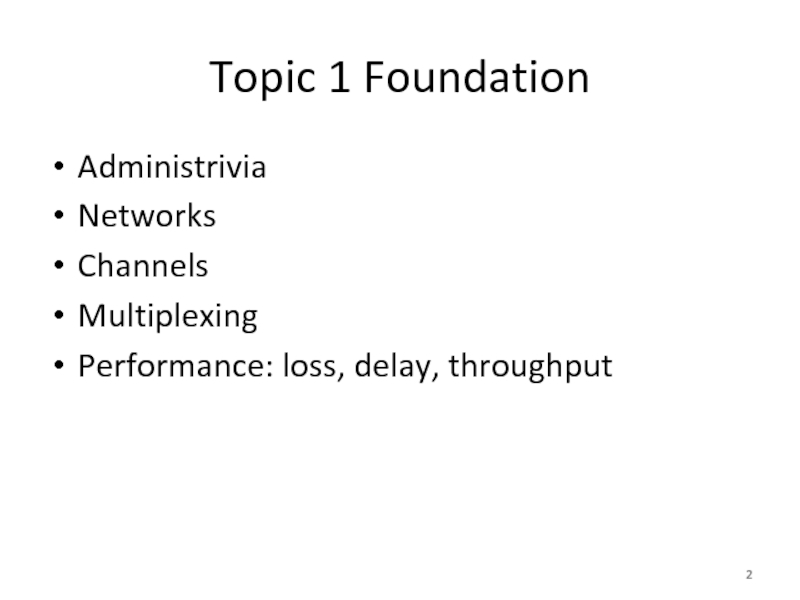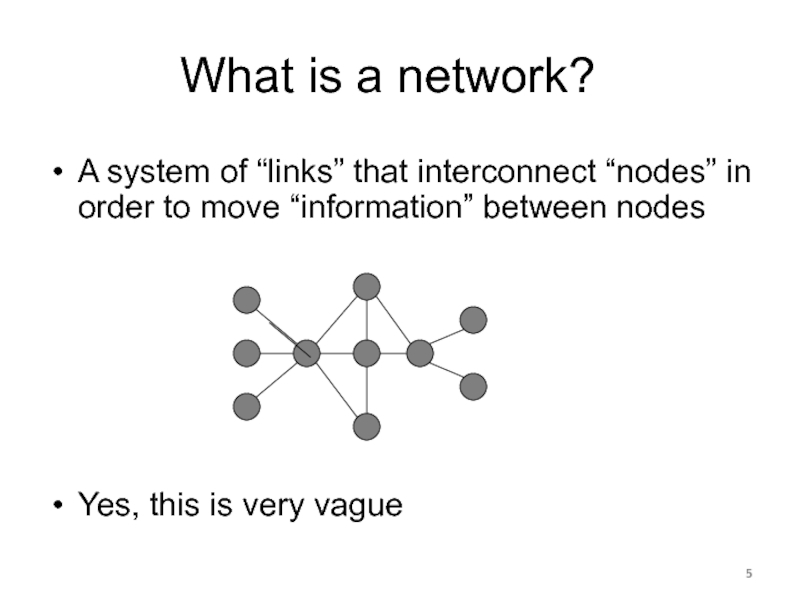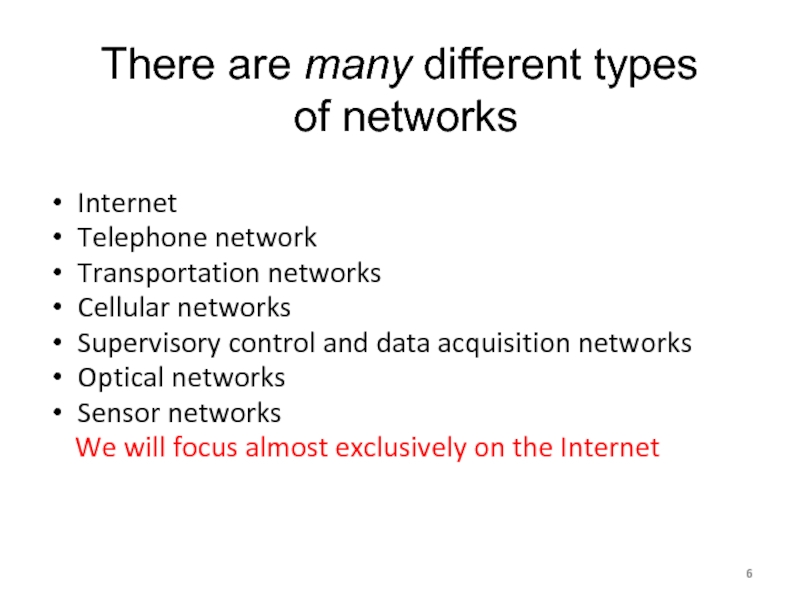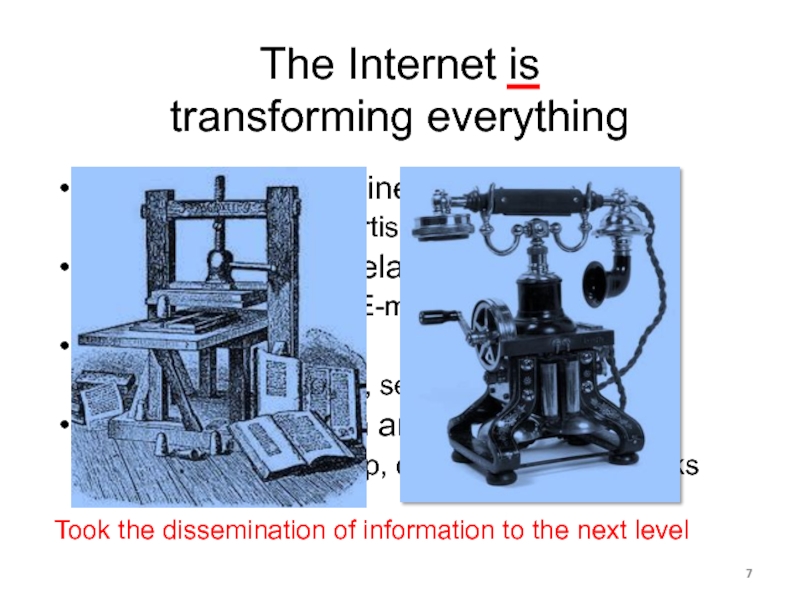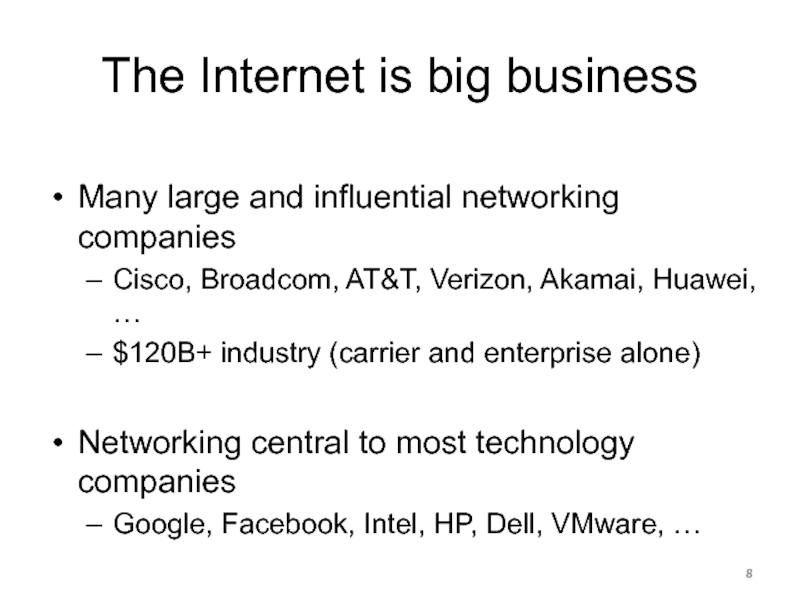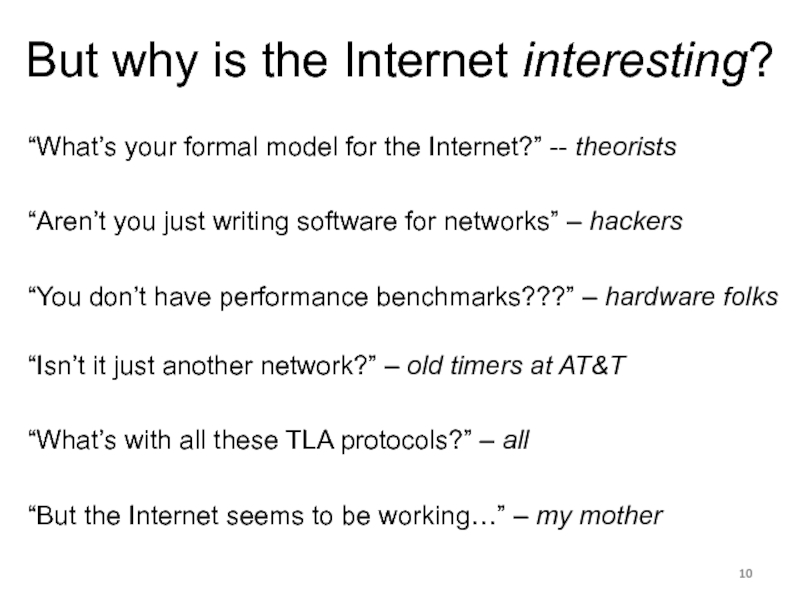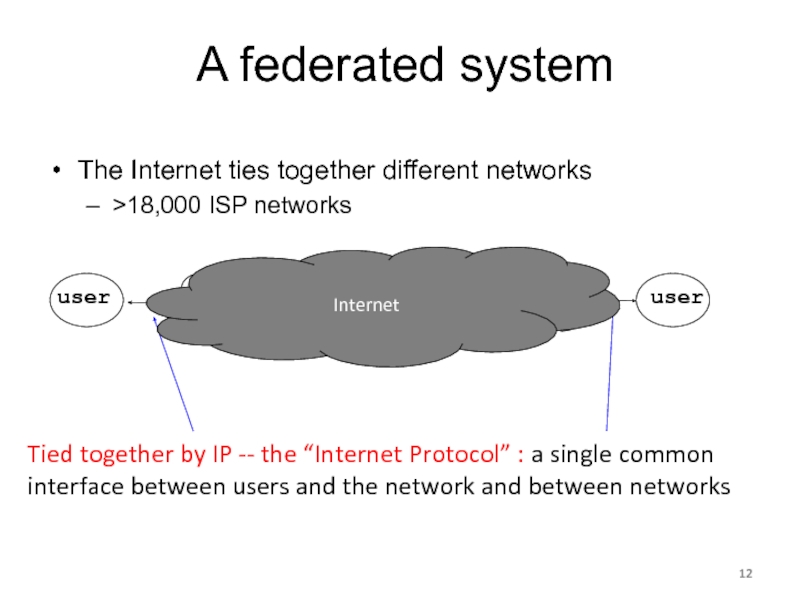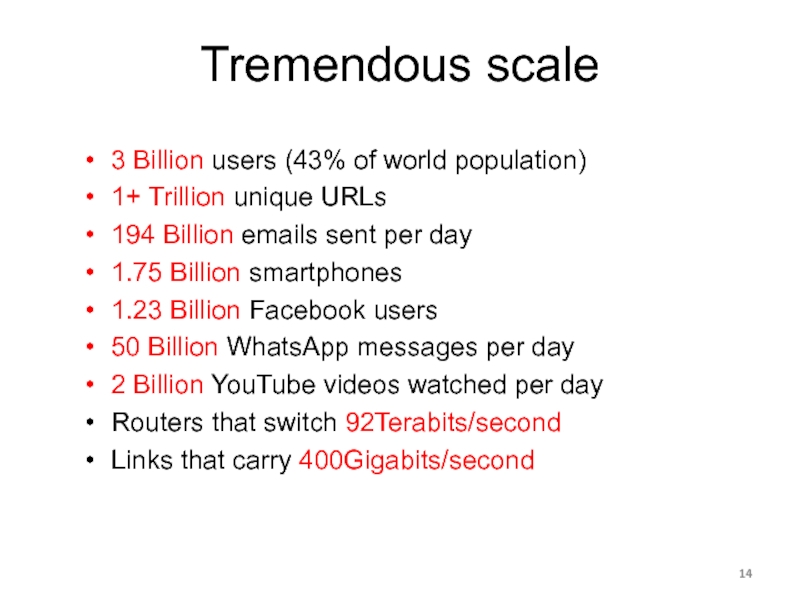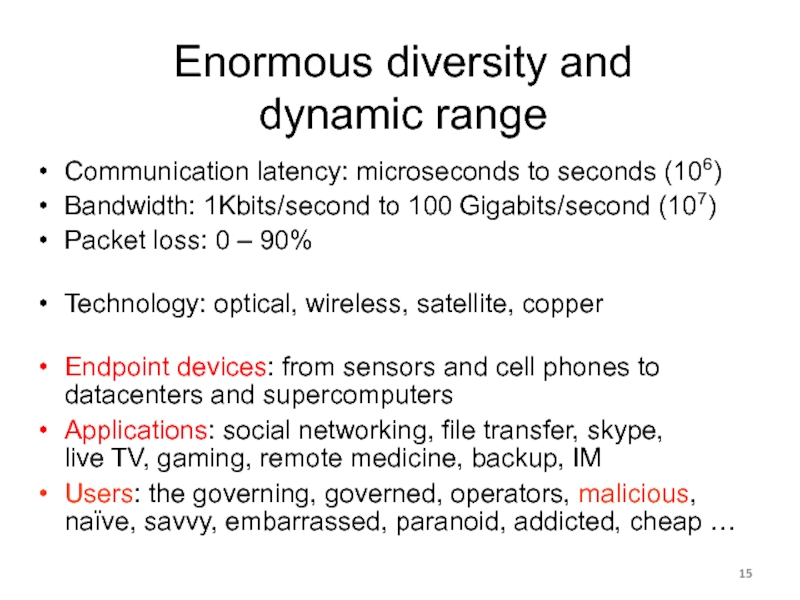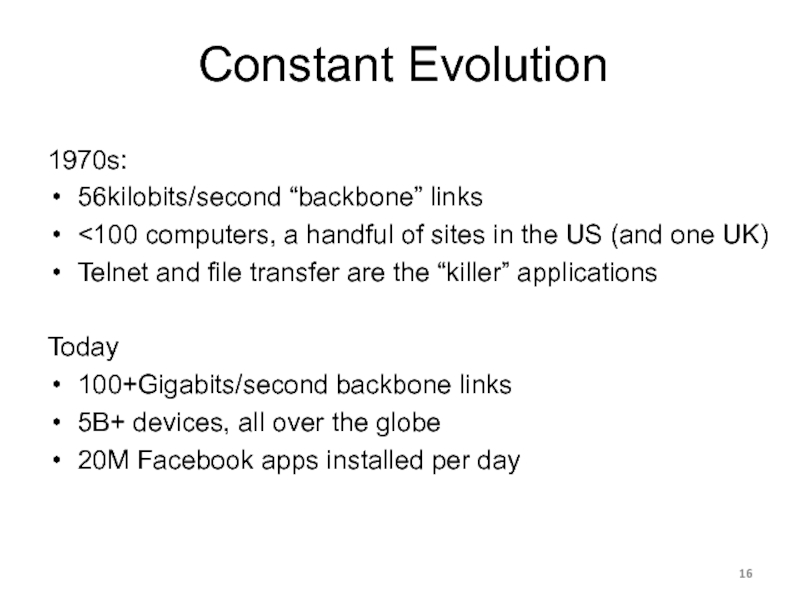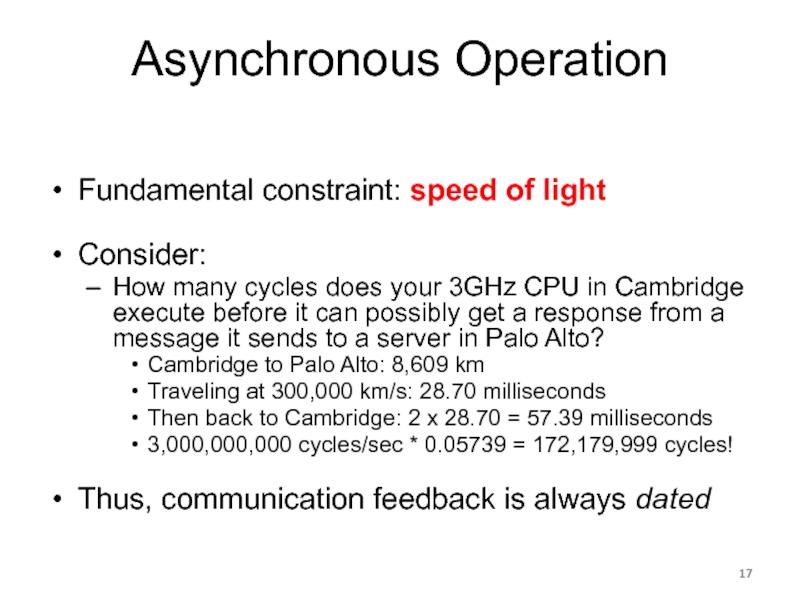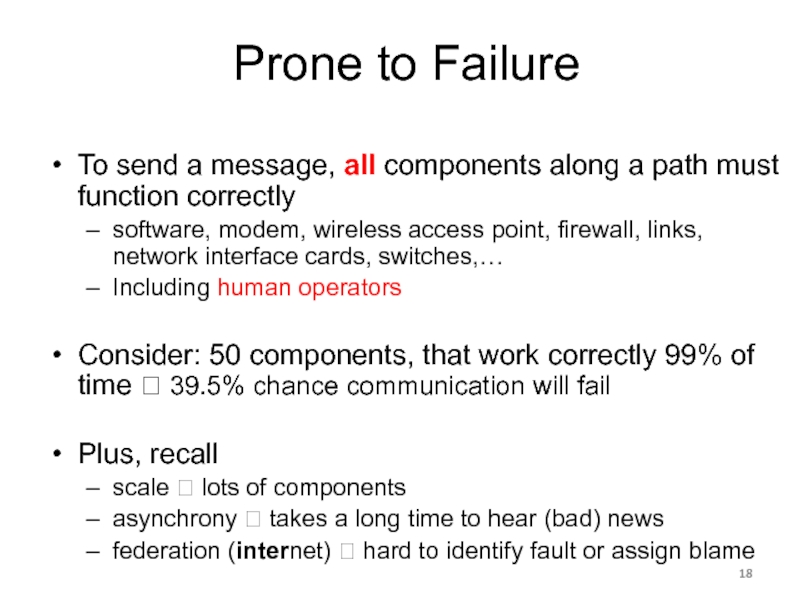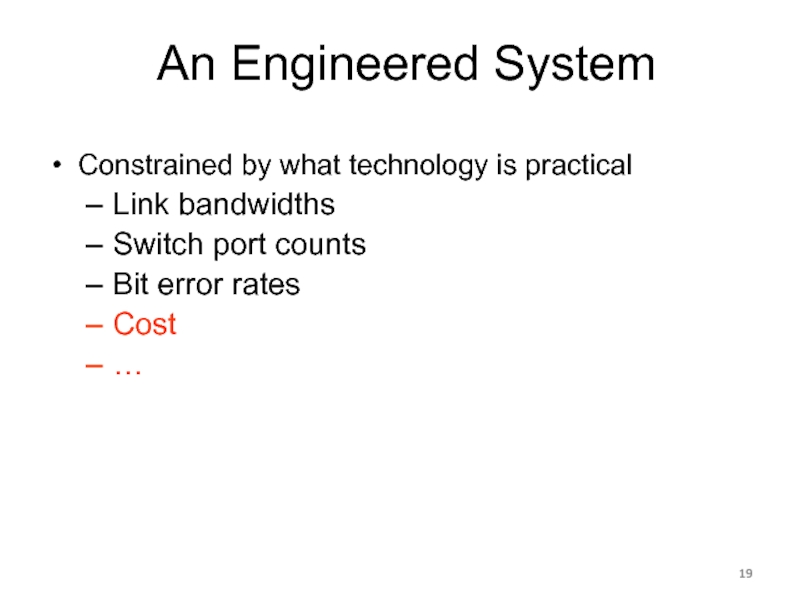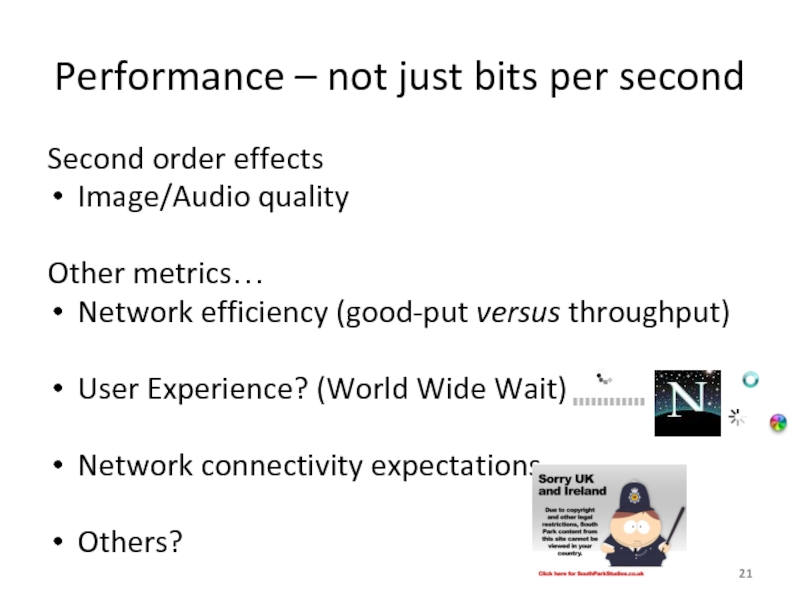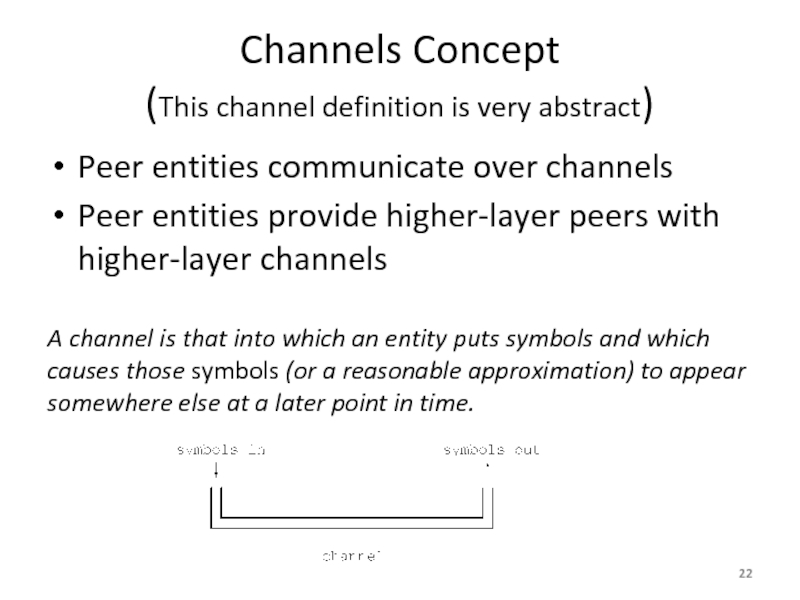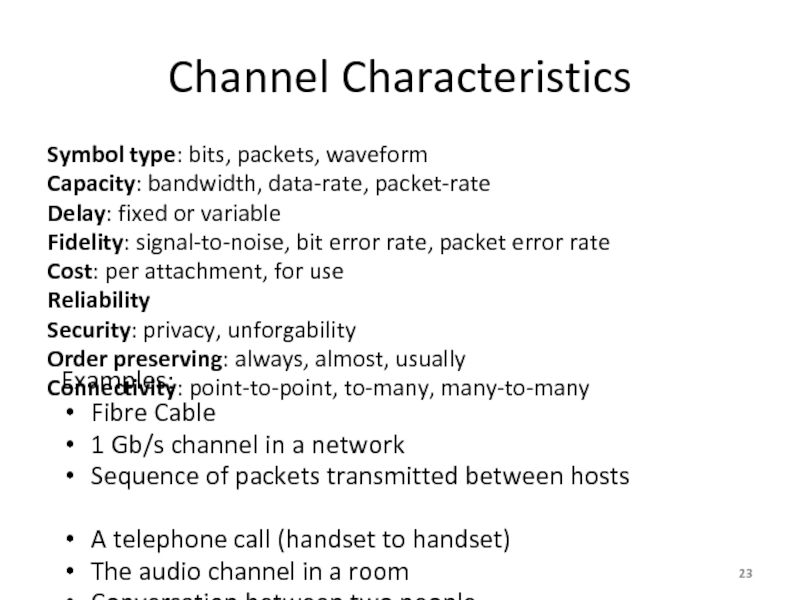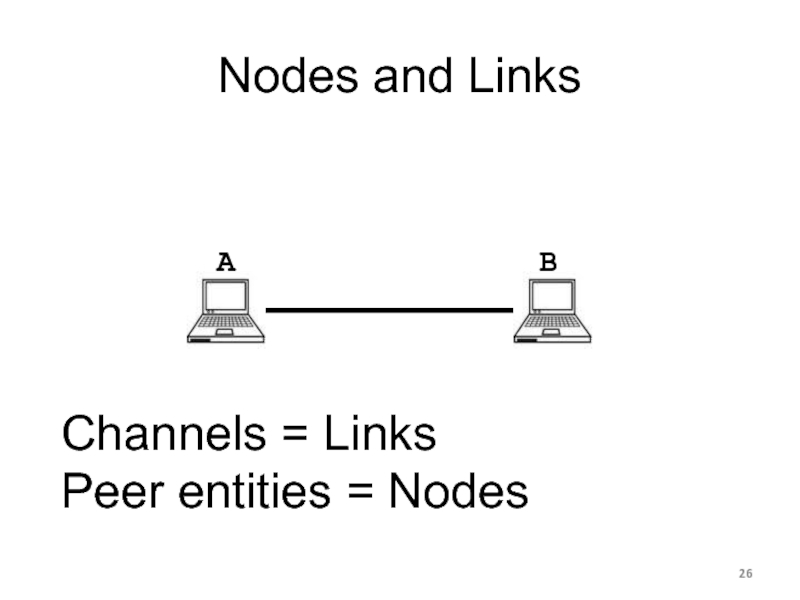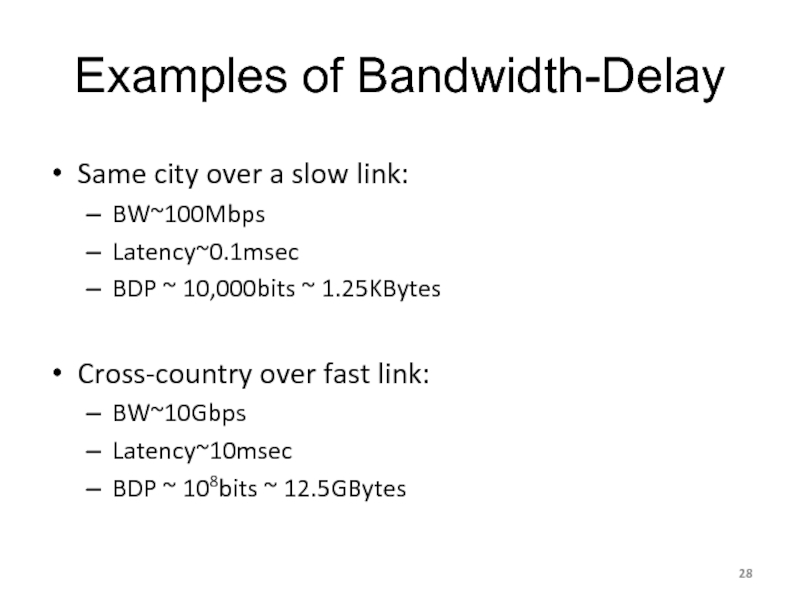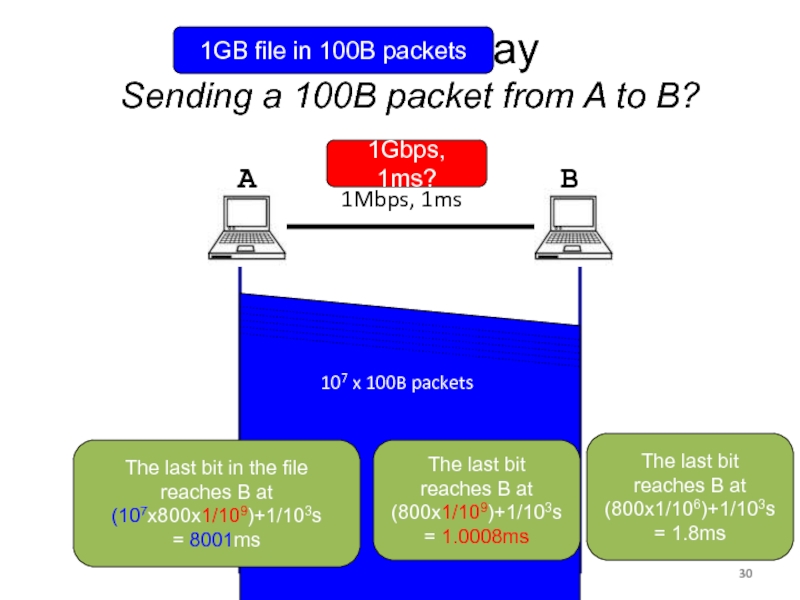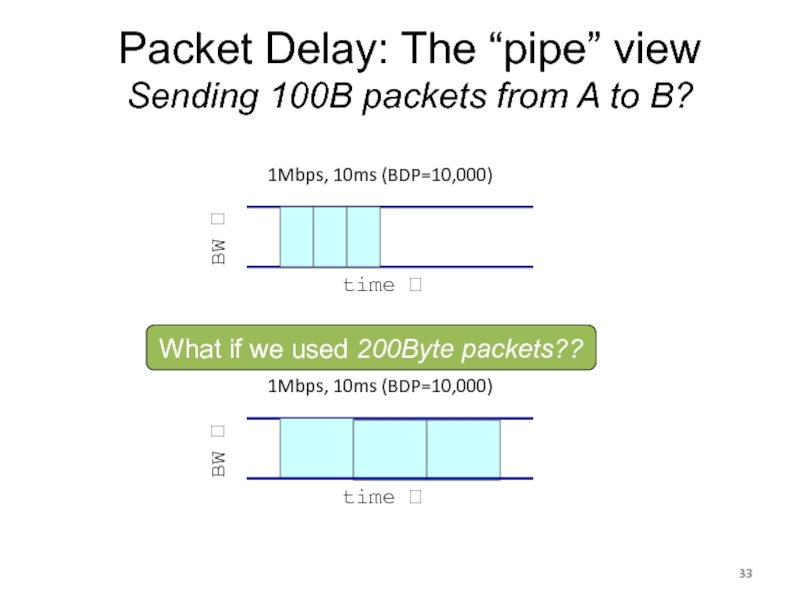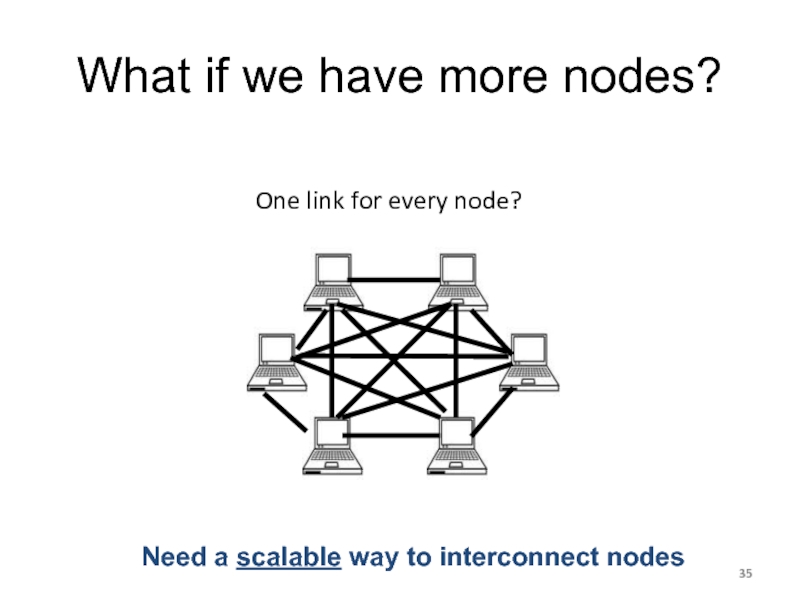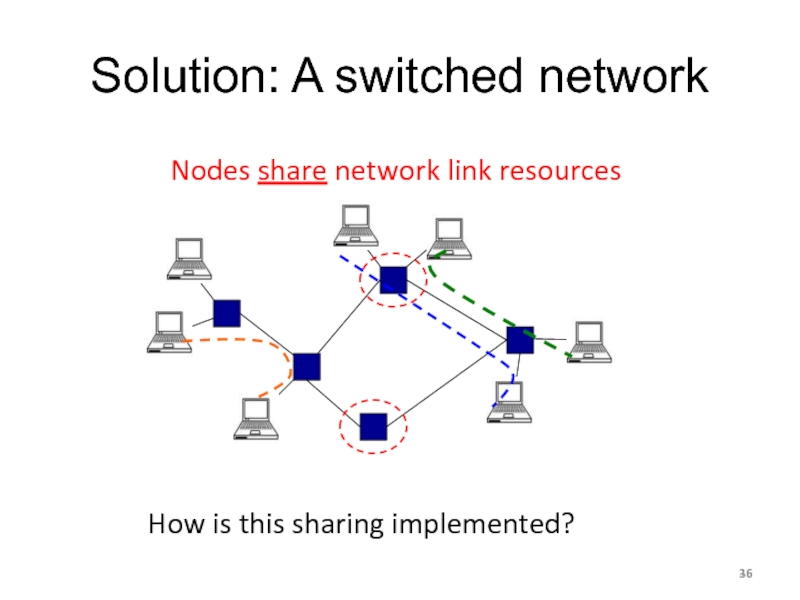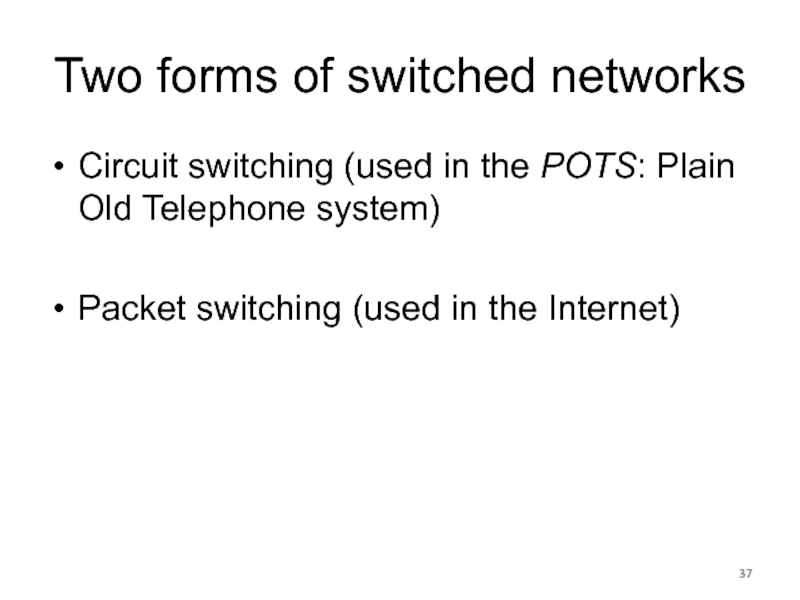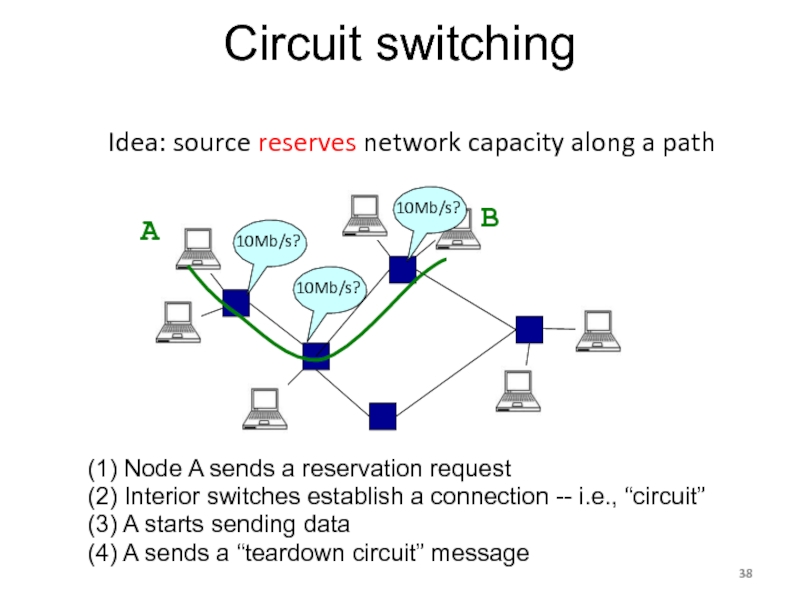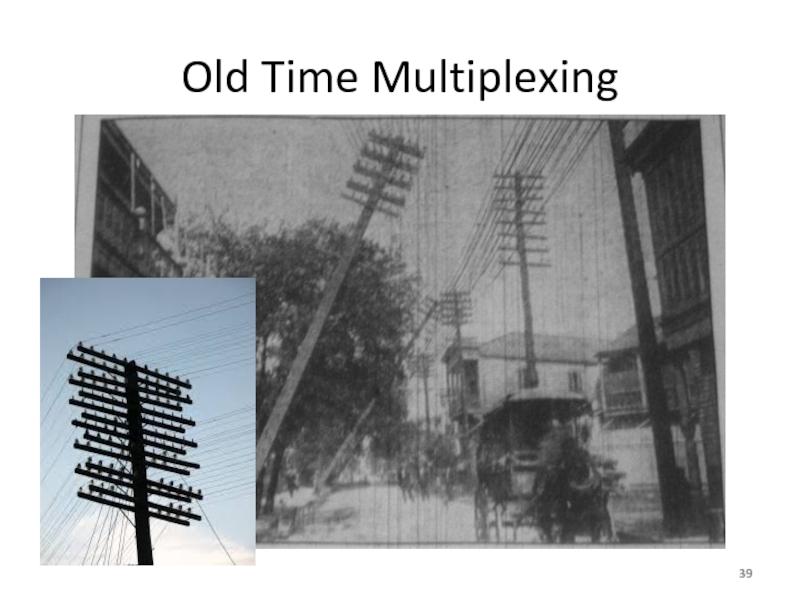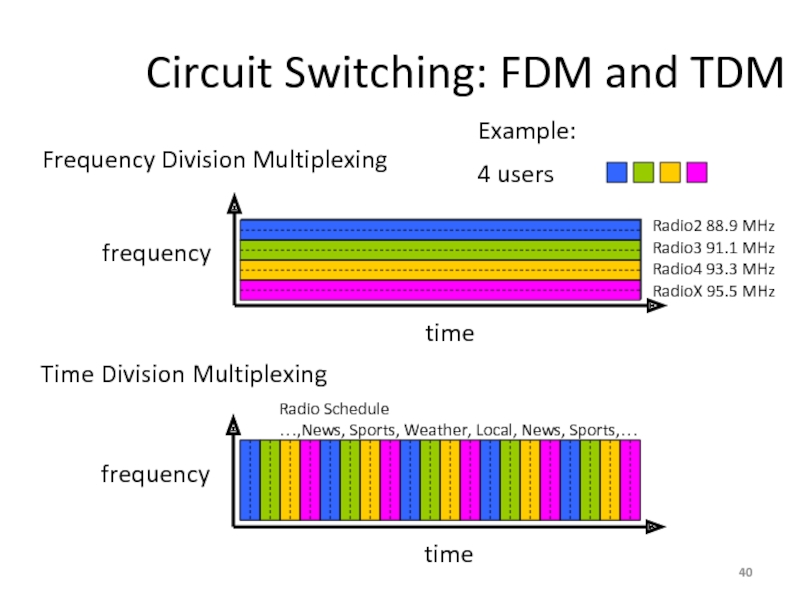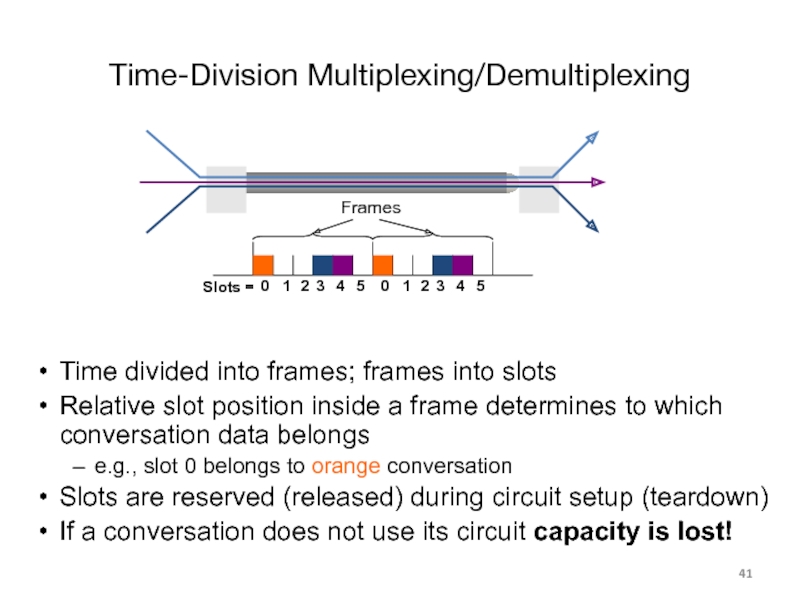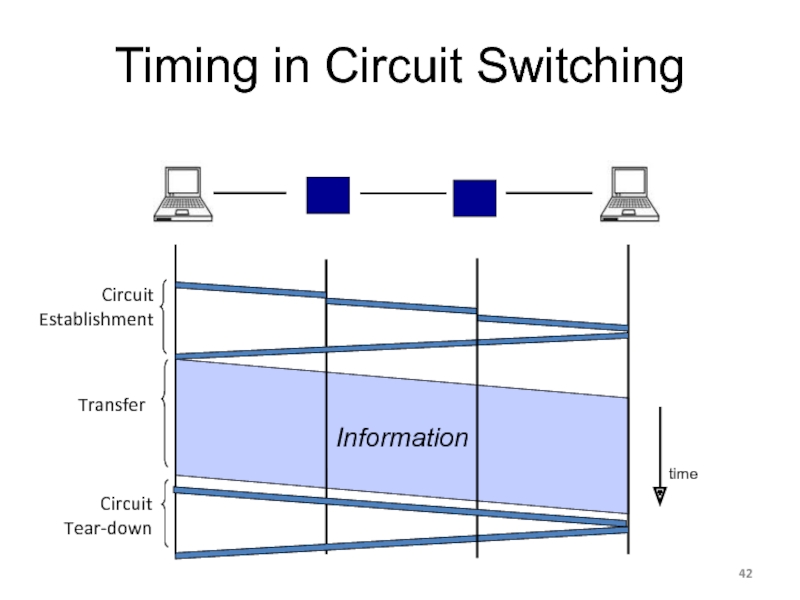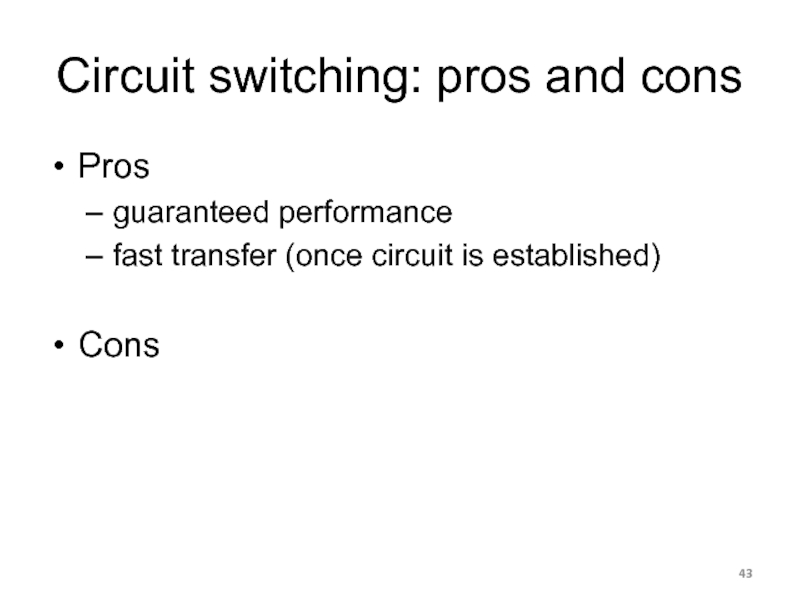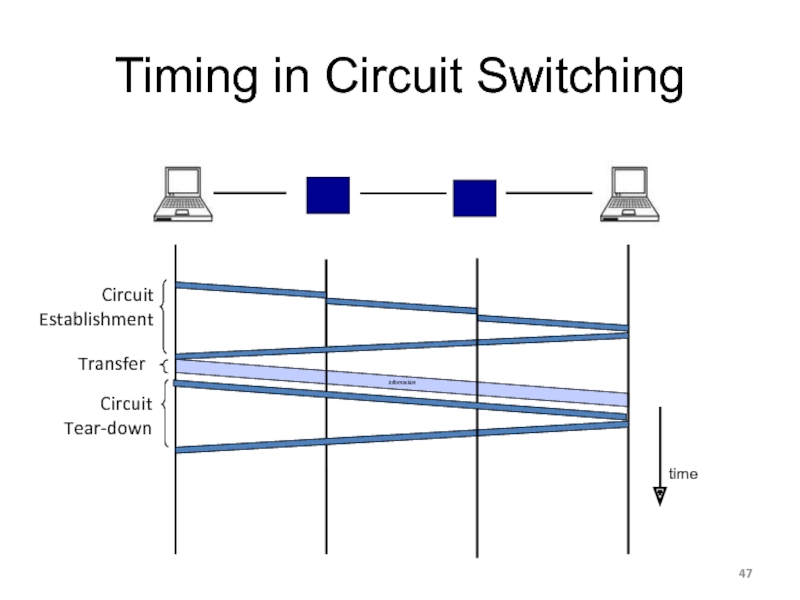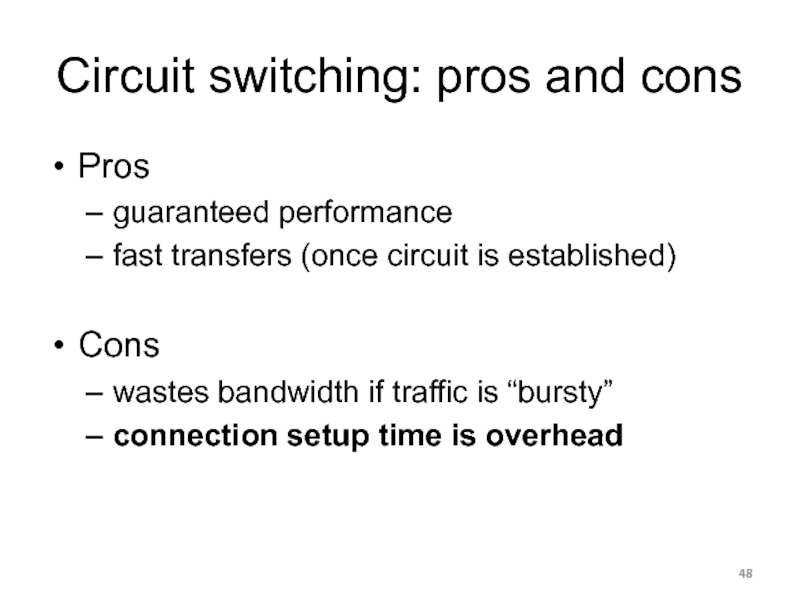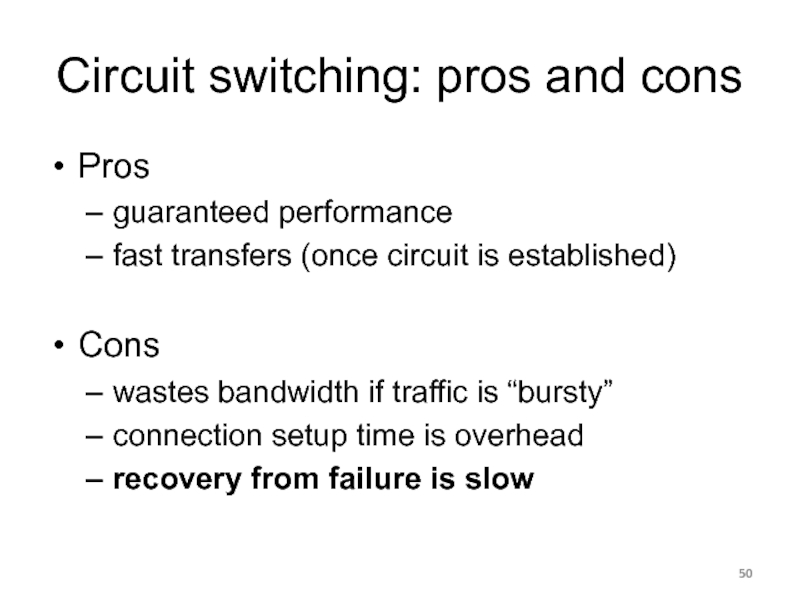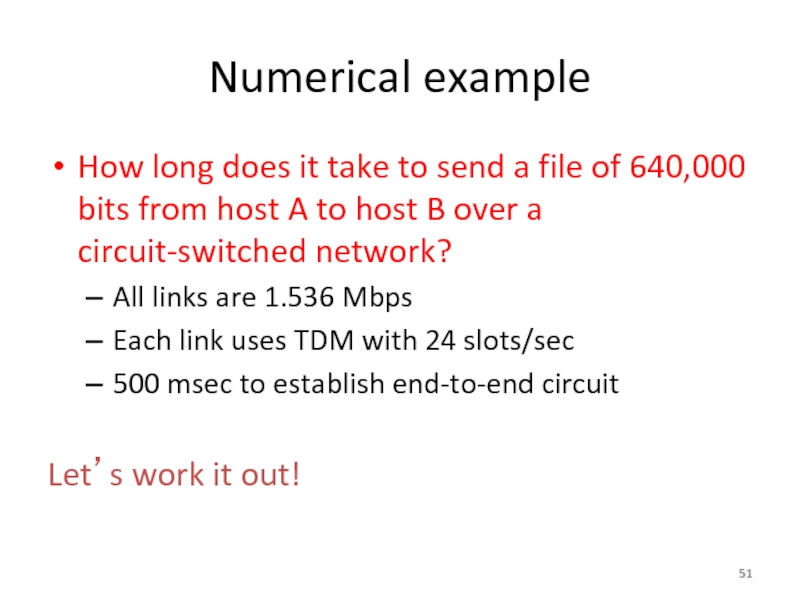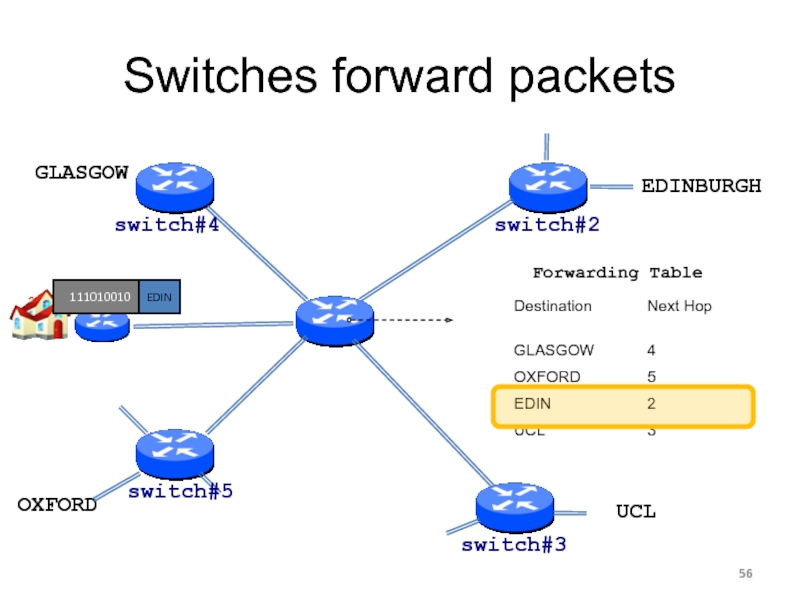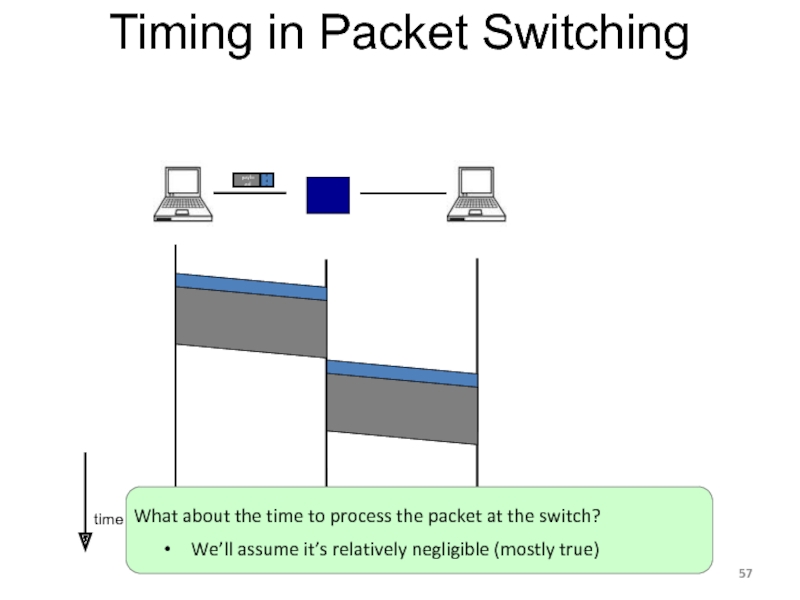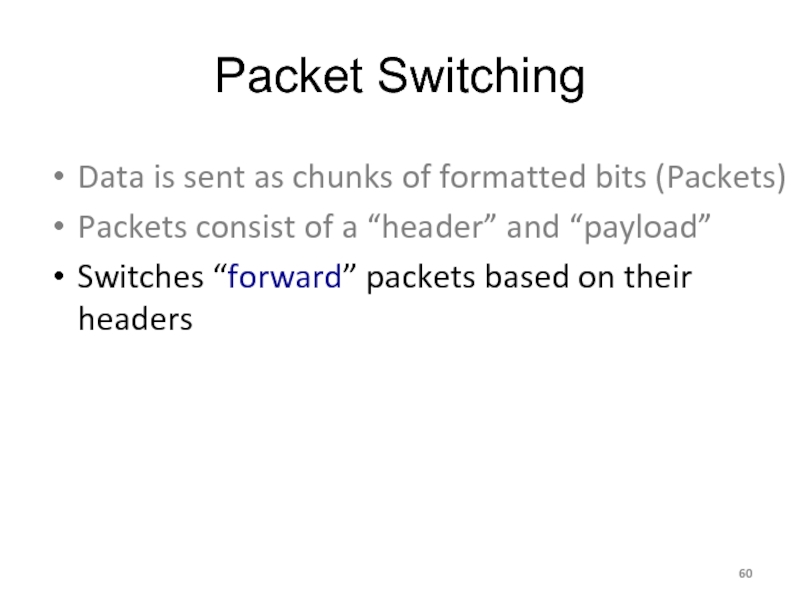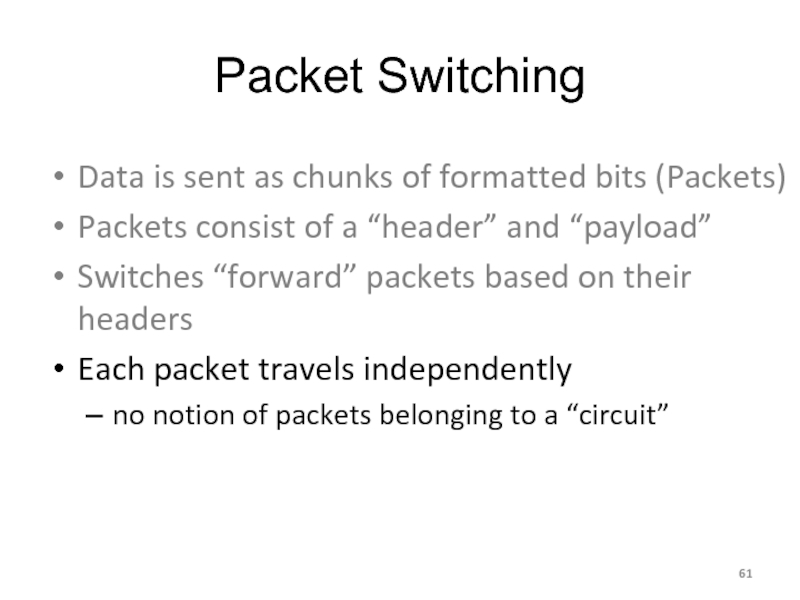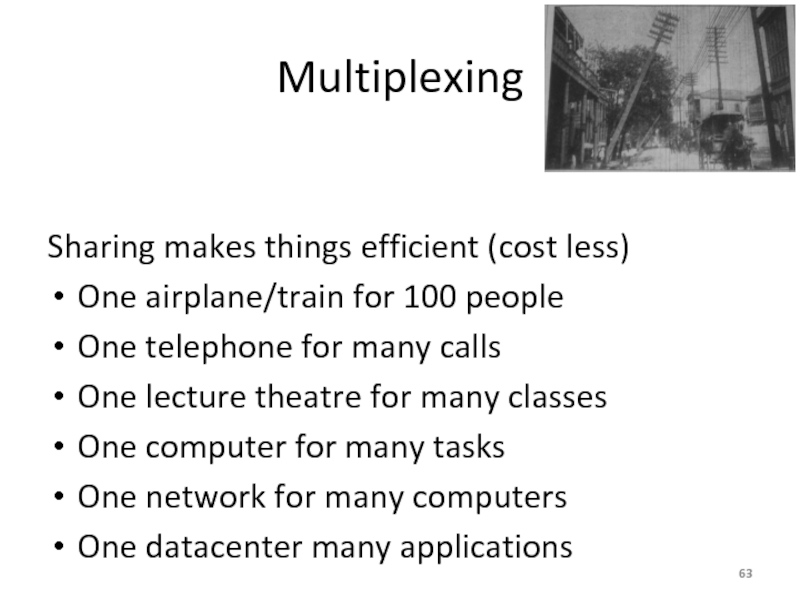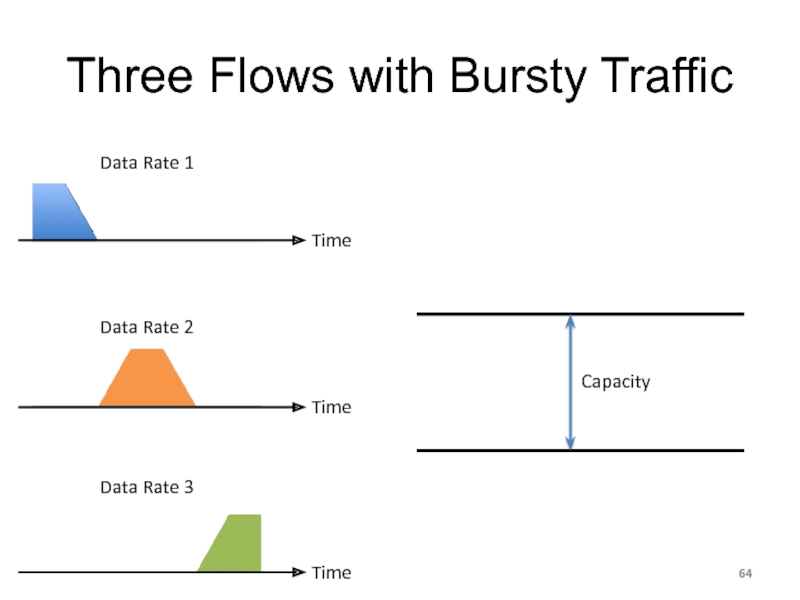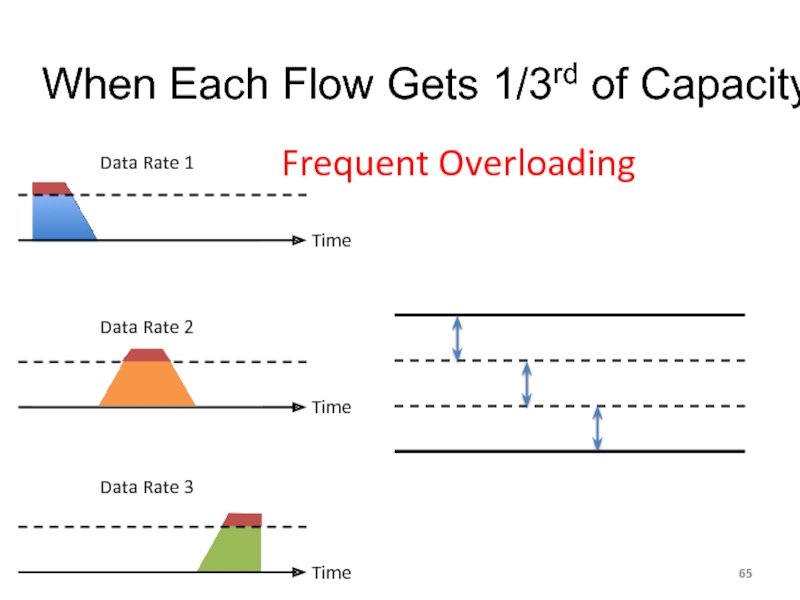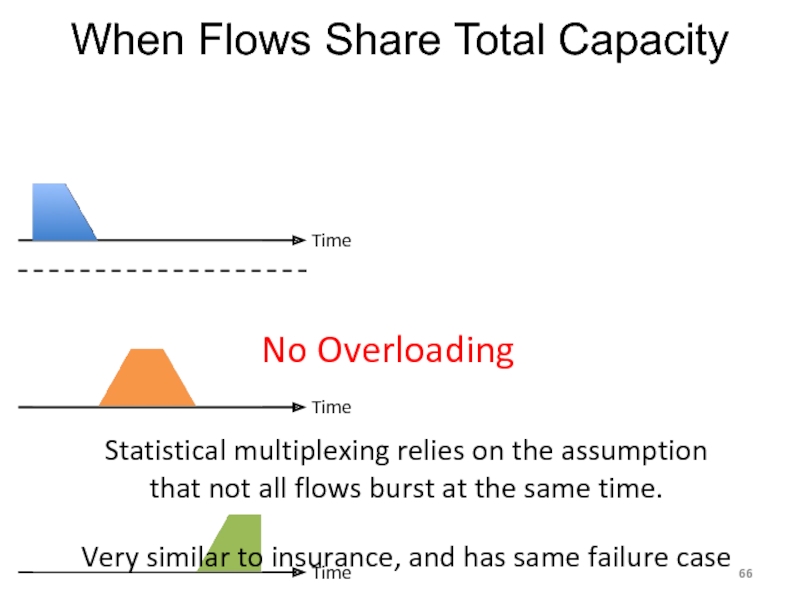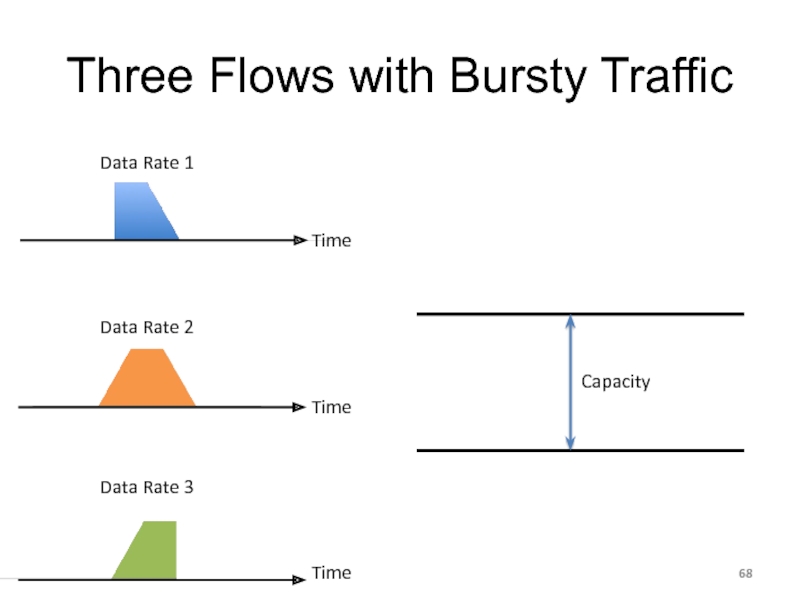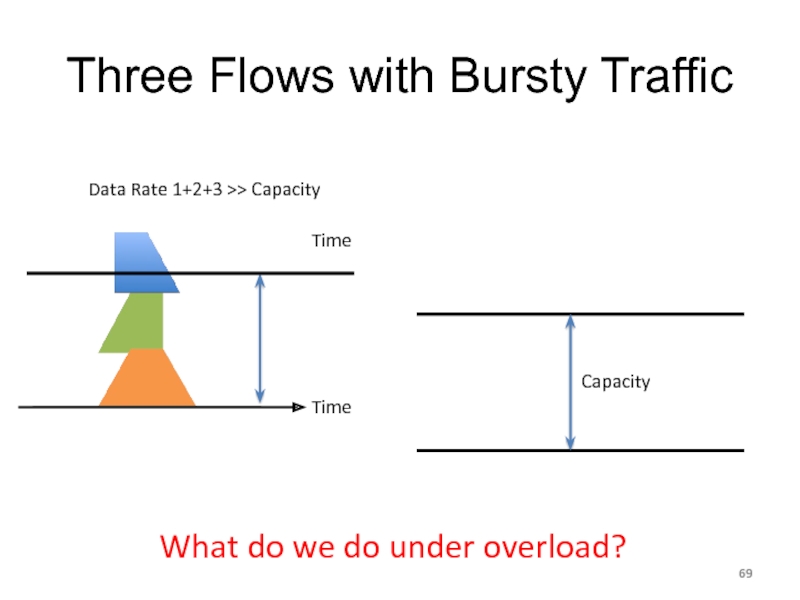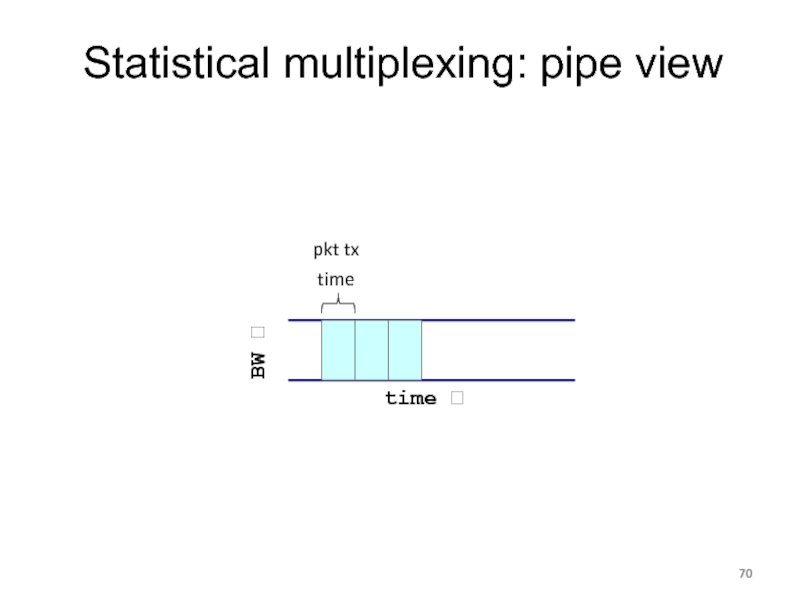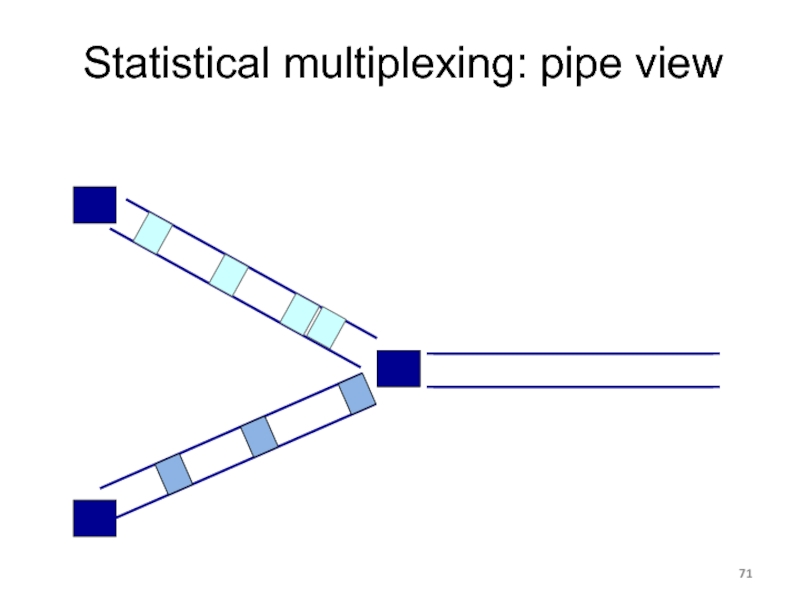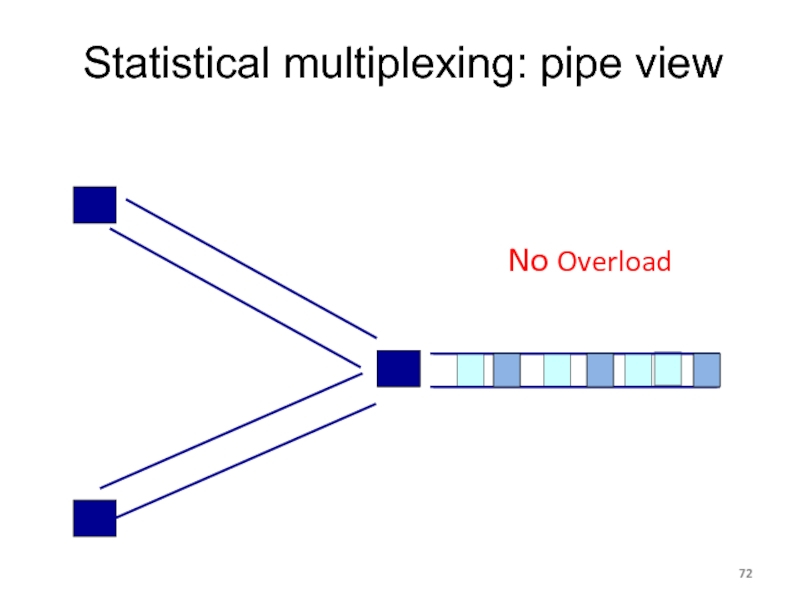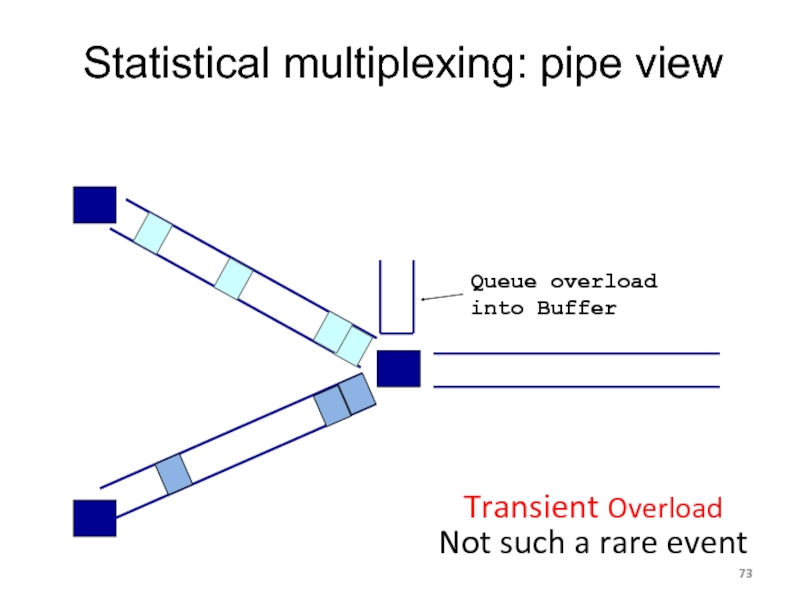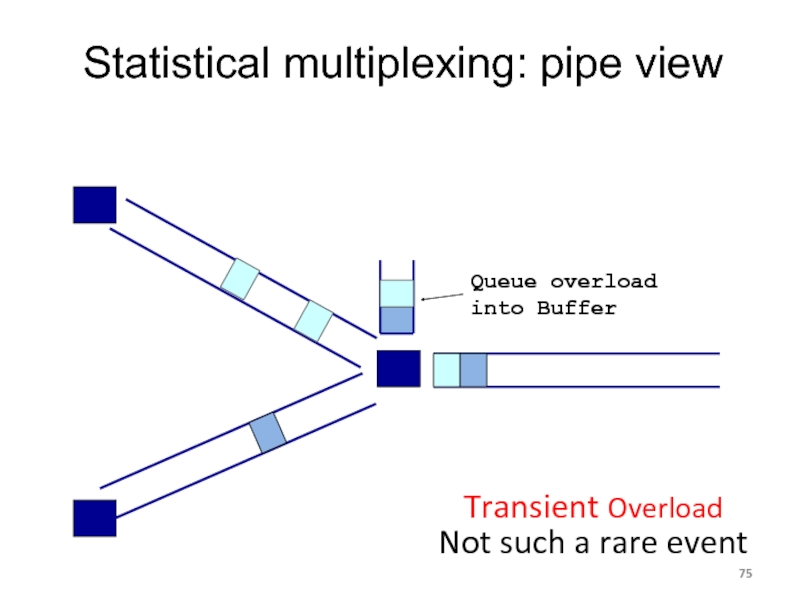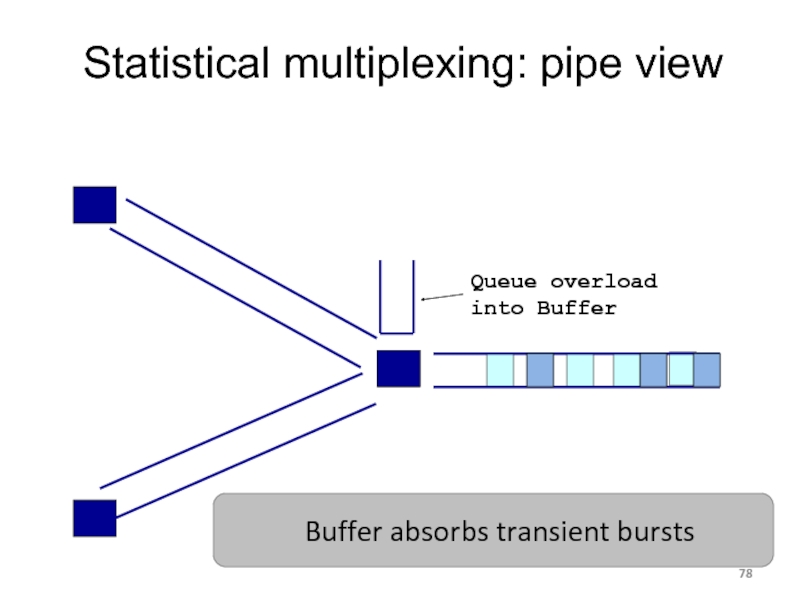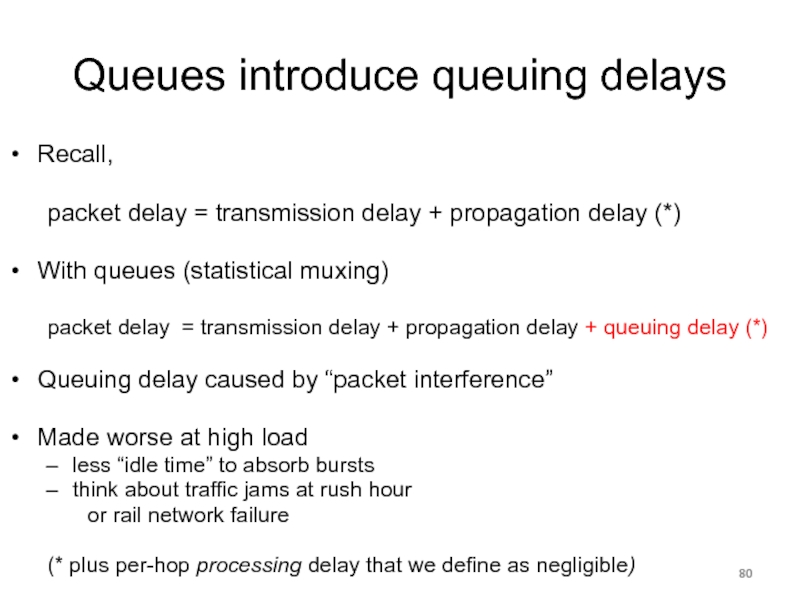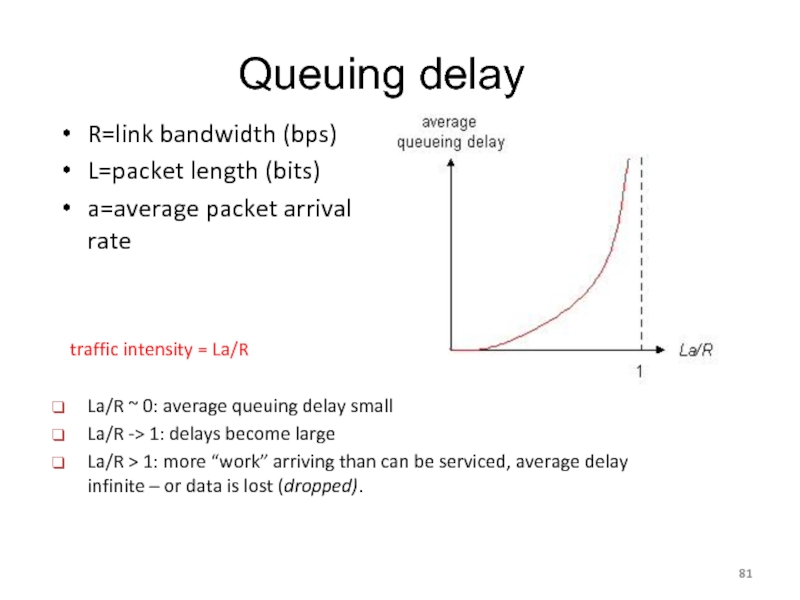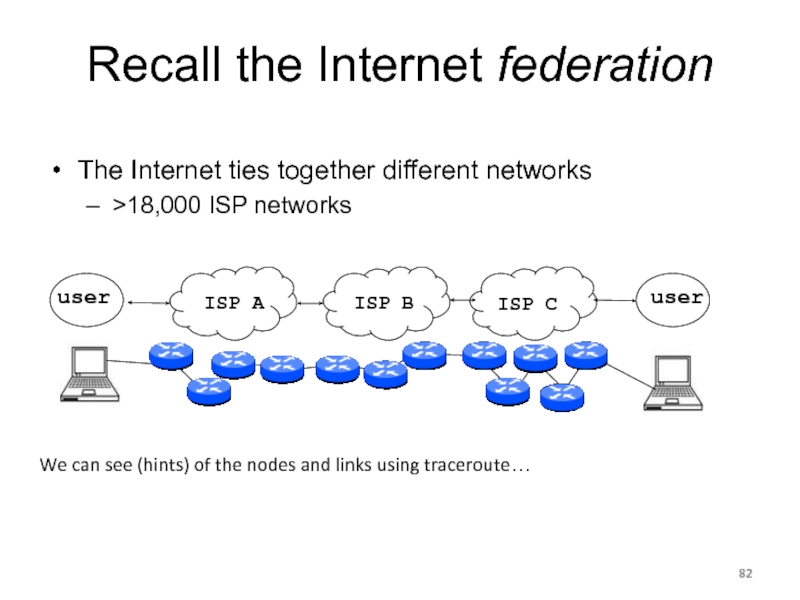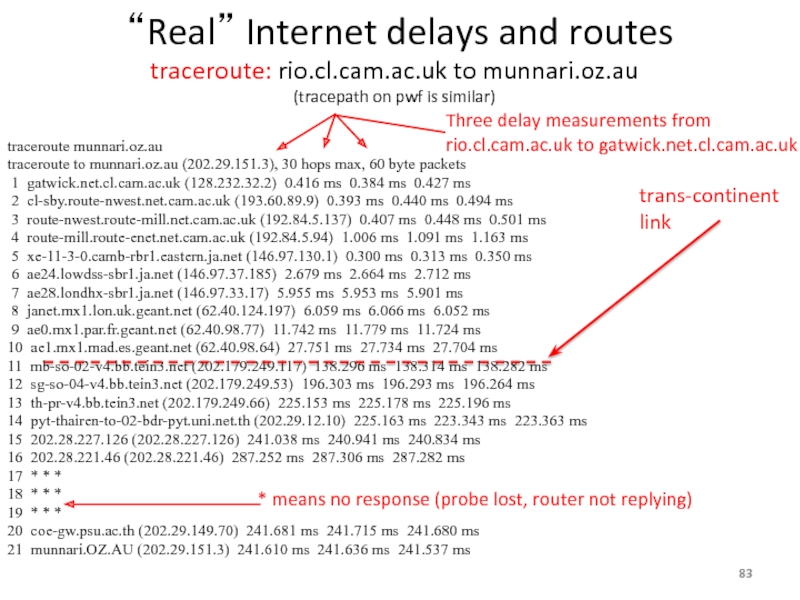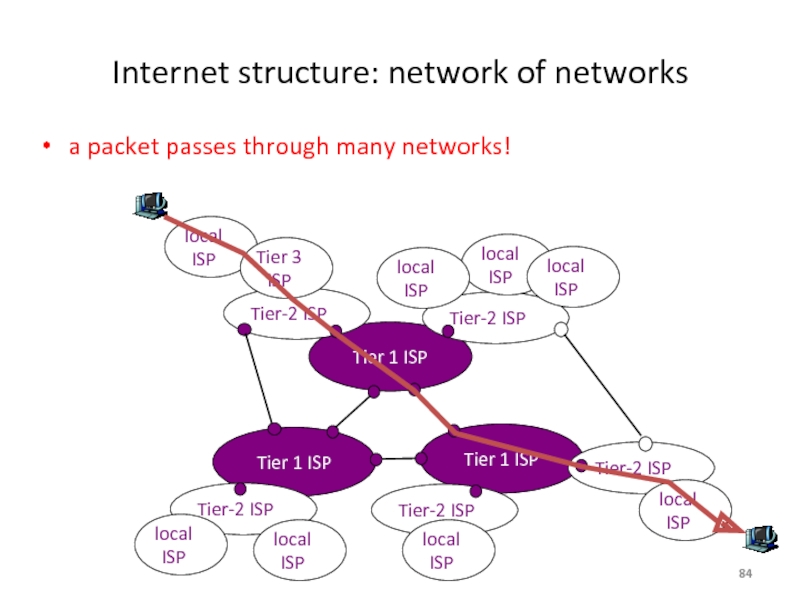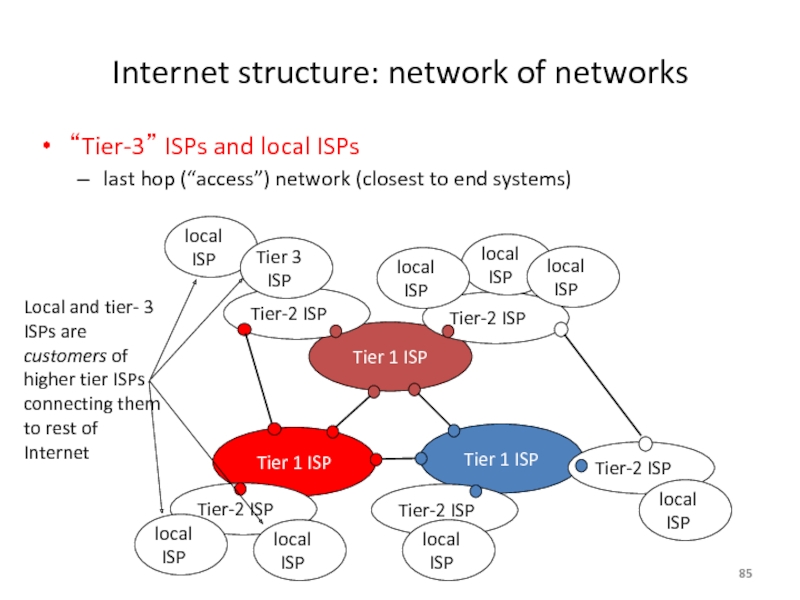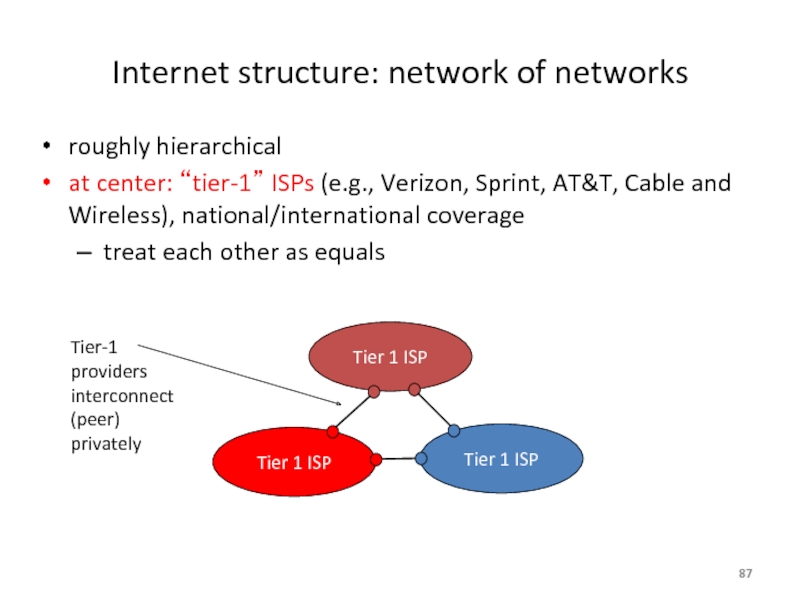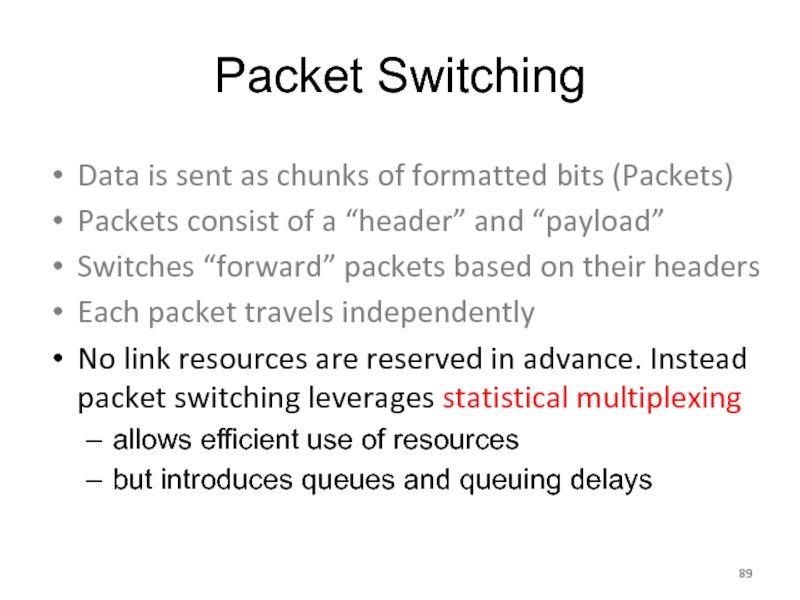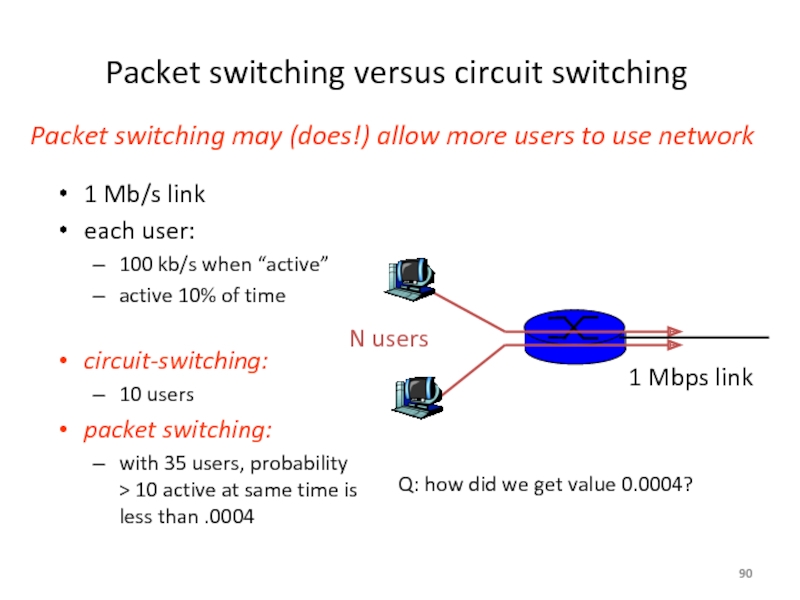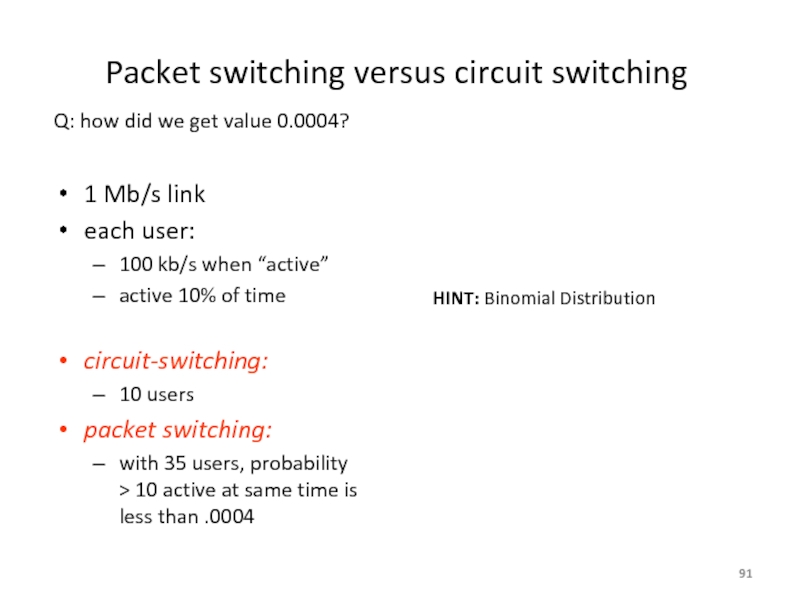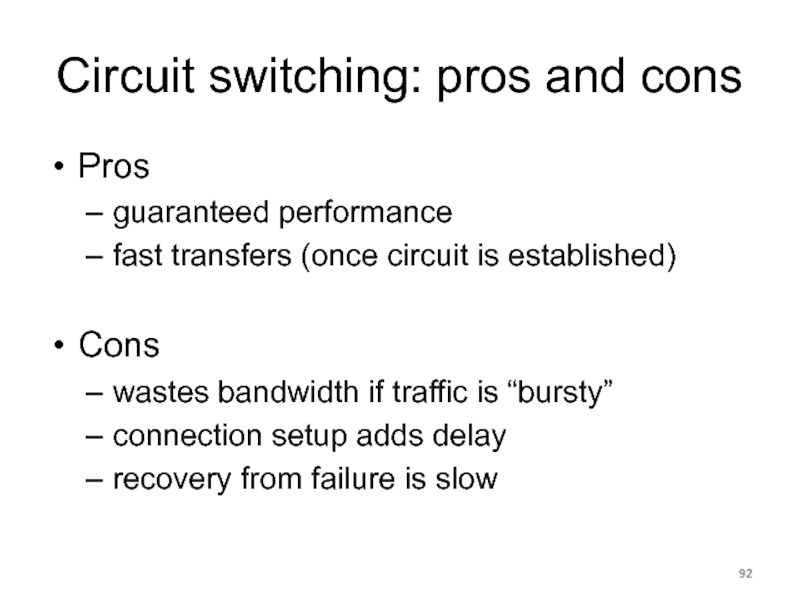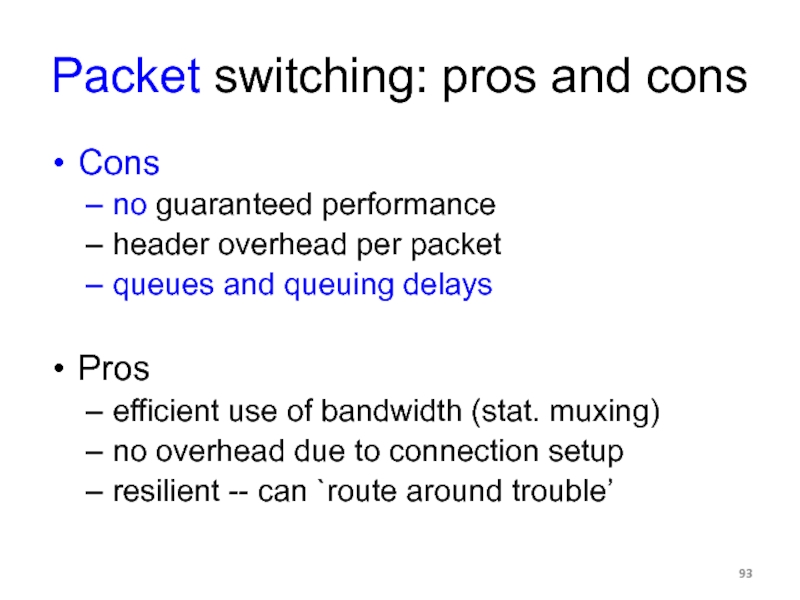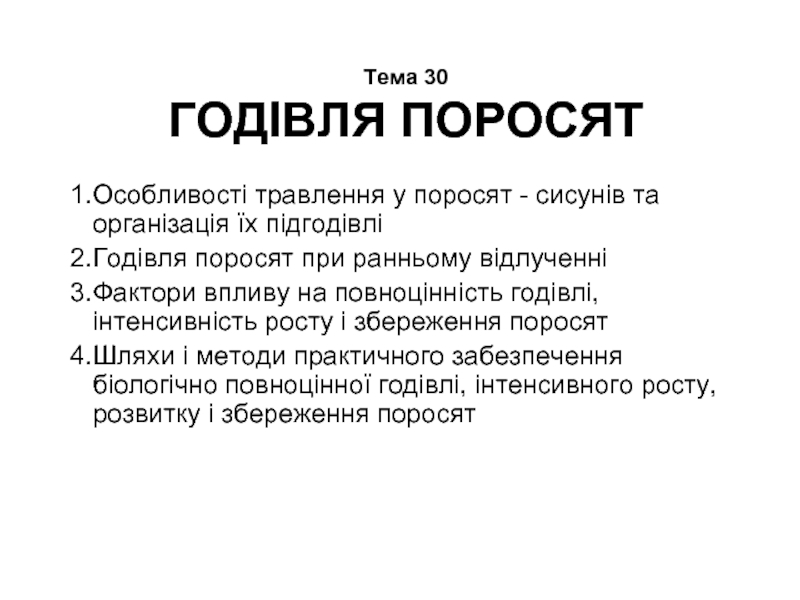- Главная
- Разное
- Дизайн
- Бизнес и предпринимательство
- Аналитика
- Образование
- Развлечения
- Красота и здоровье
- Финансы
- Государство
- Путешествия
- Спорт
- Недвижимость
- Армия
- Графика
- Культурология
- Еда и кулинария
- Лингвистика
- Английский язык
- Астрономия
- Алгебра
- Биология
- География
- Детские презентации
- Информатика
- История
- Литература
- Маркетинг
- Математика
- Медицина
- Менеджмент
- Музыка
- МХК
- Немецкий язык
- ОБЖ
- Обществознание
- Окружающий мир
- Педагогика
- Русский язык
- Технология
- Физика
- Философия
- Химия
- Шаблоны, картинки для презентаций
- Экология
- Экономика
- Юриспруденция
Computer Networking презентация
Содержание
- 1. Computer Networking
- 2. Topic 1 Foundation Administrivia Networks Channels Multiplexing Performance: loss, delay, throughput
- 3. Course Administration Commonly Available Texts Computer Networking:
- 4. Thanks Slides are a fusion of material
- 5. What is a network? A system of
- 6. There are many different types of
- 7. The Internet is transforming everything The
- 8. The Internet is big business Many large
- 9. Internet research has impact The Internet
- 10. But why is the Internet interesting? “What’s
- 11. A few defining characteristics of the Internet
- 12. A federated system The Internet ties
- 13. A federated system
- 14. Tremendous scale 3 Billion users (43% of
- 15. Enormous diversity and dynamic range
- 16. Constant Evolution 1970s: 56kilobits/second “backbone” links
- 17. Asynchronous Operation Fundamental constraint: speed of light
- 18. Prone to Failure To send a message,
- 19. An Engineered System Constrained by what technology
- 20. Recap: The Internet is… A complex federation
- 21. Performance – not just bits per second
- 22. Channels Concept (This channel definition is very
- 23. Channel Characteristics Symbol type: bits, packets, waveform
- 24. Example Physical Channels these example physical channels
- 25. More Physical media: Radio Bidirectional and multiple
- 26. Nodes and Links A B Channels = Links Peer entities = Nodes
- 27. Properties of Links (Channels) Bandwidth (capacity): “width”
- 28. Examples of Bandwidth-Delay Same city over a
- 29. time=0 Packet Delay Sending a 100B packet
- 30. Packet Delay Sending a 100B packet from
- 31. Packet Delay: The “pipe” view Sending 100B
- 32. Packet Delay: The “pipe” view Sending 100B
- 33. Packet Delay: The “pipe” view Sending 100B
- 34. Recall Nodes and Links A B
- 35. What if we have more nodes? One
- 36. Solution: A switched network
- 37. Two forms of switched networks Circuit switching
- 38. Circuit switching (1) Node A sends a
- 39. Old Time Multiplexing
- 40. Circuit Switching: FDM and TDM
- 41. Time-Division Multiplexing/Demultiplexing Time divided into frames; frames
- 42. Information
- 43. Circuit switching: pros and cons Pros guaranteed
- 44. Information
- 45. Circuit switching: pros and cons Pros guaranteed
- 46. Information
- 47. Information
- 48. Circuit switching: pros and cons Pros guaranteed
- 49. Circuit switching Circuit switching doesn’t “route around
- 50. Circuit switching: pros and cons Pros guaranteed
- 51. Numerical example How long does it take
- 52. Two forms of switched networks Circuit switching (e.g., telephone network) Packet switching (e.g., Internet)
- 53. Packet Switching Data is sent as chunks
- 54. Packet Switching Data is sent as chunks
- 55. Packet Switching Data is sent as chunks
- 56. Switches forward packets EDINBURGH OXFORD GLASGOW UCL Forwarding Table switch#2 switch#5 switch#3 switch#4
- 57. time
- 58. time
- 59. time
- 60. Packet Switching Data is sent as chunks
- 61. Packet Switching Data is sent as chunks
- 62. Packet Switching Data is sent as chunks
- 63. Multiplexing Sharing makes things efficient (cost less)
- 64. Data Rate 1 Data Rate 2 Data
- 65. Data Rate 1 Data Rate 2 Data
- 66. When Flows Share Total Capacity Time
- 67. Data Rate 1 Data Rate 2 Data
- 68. Data Rate 1 Data Rate 2 Data
- 69. Data Rate 1+2+3 >> Capacity Three Flows
- 70. Statistical multiplexing: pipe view time ? BW
- 71. Statistical multiplexing: pipe view
- 72. Statistical multiplexing: pipe view No Overload
- 73. Statistical multiplexing: pipe view
- 74. Statistical multiplexing: pipe view
- 75. Statistical multiplexing: pipe view
- 76. Statistical multiplexing: pipe view
- 77. Statistical multiplexing: pipe view
- 78. Statistical multiplexing: pipe view
- 79. Statistical multiplexing: pipe view
- 80. Queues introduce queuing delays Recall, packet
- 81. Queuing delay R=link bandwidth (bps) L=packet length
- 82. Recall the Internet federation The Internet ties
- 83. “Real” Internet delays and routes traceroute munnari.oz.au
- 84. Internet structure: network of networks a packet
- 85. Internet structure: network of networks “Tier-3” ISPs
- 86. Internet structure: network of networks “Tier-2” ISPs:
- 87. Internet structure: network of networks roughly hierarchical
- 88. Tier-1 ISP: e.g., Sprint
- 89. Packet Switching Data is sent as chunks
- 90. Packet switching versus circuit switching 1 Mb/s
- 91. Packet switching versus circuit switching 1 Mb/s
- 92. Circuit switching: pros and cons Pros
- 93. Packet switching: pros and cons Cons
- 94. Summary A sense of how the basic
Слайд 1Computer Networking
Michaelmas/Lent Term
M/W/F 11:00-12:00
LT1 in Gates Building
Slide Set 1
Andrew W. Moore
andrew.moore@cl.cam.ac.uk
2014-2015
Слайд 2Topic 1 Foundation
Administrivia
Networks
Channels
Multiplexing
Performance: loss, delay, throughput
Слайд 3Course Administration
Commonly Available Texts
Computer Networking: A Top-Down Approach
Kurose and Ross, 6th
(5th edition is also commonly available)
Computer Networks: A Systems Approach
Peterson and Davie, 5th edition 2011, Morgan-Kaufman
Other Selected Texts (non-representative)
Internetworking with TCP/IP, vol. I + II
Comer & Stevens, Prentice Hall
UNIX Network Programming, Vol. I
Stevens, Fenner & Rudoff, Prentice Hall
Слайд 4Thanks
Slides are a fusion of material from
Ian Leslie, Richard Black, Jim
Supervision material is drawn from
Stephen Kell, Andy Rice, and the fantastic TA teams of 144 and 168
Practical material will become available through this year
But would be impossible without Georgina Kalogeridou,
Nick McKeown, Bob Lantz, Te-Yuan Huang and Vimal Jeyakumar
Finally thanks to the Part 1b students past and Andrew Rice for all the tremendous feedback.
Слайд 5What is a network?
A system of “links” that interconnect “nodes” in
Yes, this is very vague
Слайд 6There are many different types
of networks
Internet
Telephone network
Transportation networks
Cellular networks
Supervisory
Optical networks
Sensor networks
We will focus almost exclusively on the Internet
Слайд 7The Internet is
transforming everything
The way we do business
E-commerce, advertising, cloud-computing
The
Facebook friends, E-mail, IM, virtual worlds
The way we learn
Wikipedia, MOOCs, search engines
The way we govern and view law
E-voting, censorship, copyright, cyber-attacks
Took the dissemination of information to the next level
Слайд 8The Internet is big business
Many large and influential networking companies
Cisco, Broadcom,
$120B+ industry (carrier and enterprise alone)
Networking central to most technology companies
Google, Facebook, Intel, HP, Dell, VMware, …
Слайд 9Internet research has impact
The Internet started as a research experiment!
4 of
Many successful companies have emerged from networking research(ers)
Слайд 10But why is the Internet interesting?
“What’s your formal model for the
“Aren’t you just writing software for networks” – hackers
“You don’t have performance benchmarks???” – hardware folks
“Isn’t it just another network?” – old timers at AT&T
“What’s with all these TLA protocols?” – all
“But the Internet seems to be working…” – my mother
Слайд 12 A federated system
The Internet ties together different networks
>18,000 ISP networks
Internet
Слайд 13 A federated system
A single, common interface is great for interoperability…
…but tricky for business
Why does this matter?
ease of interoperability is the Internet’s most important goal
practical realities of incentives, economics and real-world trust drive topology, route selection and service evolution
The Internet ties together different networks
>18,000 ISP networks
Слайд 14Tremendous scale
3 Billion users (43% of world population)
1+ Trillion unique URLs
194 Billion emails sent per day
1.75 Billion smartphones
1.23 Billion Facebook users
50 Billion WhatsApp messages per day
2 Billion YouTube videos watched per day
Routers that switch 92Terabits/second
Links that carry 400Gigabits/second
Слайд 15Enormous diversity and
dynamic range
Communication latency: microseconds to seconds (106)
Bandwidth:
Packet loss: 0 – 90%
Technology: optical, wireless, satellite, copper
Endpoint devices: from sensors and cell phones to datacenters and supercomputers
Applications: social networking, file transfer, skype, live TV, gaming, remote medicine, backup, IM
Users: the governing, governed, operators, malicious, naïve, savvy, embarrassed, paranoid, addicted, cheap …
Слайд 16Constant Evolution
1970s:
56kilobits/second “backbone” links
Telnet and file transfer are the “killer” applications
Today
100+Gigabits/second backbone links
5B+ devices, all over the globe
20M Facebook apps installed per day
Слайд 17Asynchronous Operation
Fundamental constraint: speed of light
Consider:
How many cycles does your
Cambridge to Palo Alto: 8,609 km
Traveling at 300,000 km/s: 28.70 milliseconds
Then back to Cambridge: 2 x 28.70 = 57.39 milliseconds
3,000,000,000 cycles/sec * 0.05739 = 172,179,999 cycles!
Thus, communication feedback is always dated
Слайд 18Prone to Failure
To send a message, all components along a path
software, modem, wireless access point, firewall, links, network interface cards, switches,…
Including human operators
Consider: 50 components, that work correctly 99% of time ? 39.5% chance communication will fail
Plus, recall
scale ? lots of components
asynchrony ? takes a long time to hear (bad) news
federation (internet) ? hard to identify fault or assign blame
Слайд 19An Engineered System
Constrained by what technology is practical
Link bandwidths
Switch port
Bit error rates
Cost
…
Слайд 20Recap: The Internet is…
A complex federation
Of enormous scale
Dynamic range
Diversity
Constantly evolving
Asynchronous in operation
Failure prone
Constrained by what’s practical to engineer
Too complex for theoretical models
“Working code” doesn’t mean much
Performance benchmarks are too narrow
Слайд 21Performance – not just bits per second
Second order effects
Image/Audio quality
Other metrics…
Network
User Experience? (World Wide Wait)
Network connectivity expectations
Others?
Слайд 22Channels Concept
(This channel definition is very abstract)
Peer entities communicate over channels
Peer
A channel is that into which an entity puts symbols and which causes those symbols (or a reasonable approximation) to appear somewhere else at a later point in time.
Слайд 23Channel Characteristics
Symbol type: bits, packets, waveform
Capacity: bandwidth, data-rate, packet-rate
Delay: fixed or
Fidelity: signal-to-noise, bit error rate, packet error rate
Cost: per attachment, for use
Reliability
Security: privacy, unforgability
Order preserving: always, almost, usually
Connectivity: point-to-point, to-many, many-to-many
Examples:
Fibre Cable
1 Gb/s channel in a network
Sequence of packets transmitted between hosts
A telephone call (handset to handset)
The audio channel in a room
Conversation between two people
Слайд 24Example Physical Channels these example physical channels are also known as Physical
Twisted Pair (TP)
two insulated copper wires
Category 3: traditional phone wires, 10 Mbps Ethernet
Category 6:
1Gbps Ethernet
Shielded (STP)
Unshielded (UTP)
Coaxial cable:
two concentric copper conductors
bidirectional
baseband:
single channel on cable
legacy Ethernet
broadband:
multiple channels on cable
HFC (Hybrid Fiber Coax)
Fiber optic cable:
high-speed operation
point-to-point transmission
(10’s-100’s Gps)
low error rate
immune to electromagnetic noise
Слайд 25More Physical media: Radio
Bidirectional and multiple access
propagation environment effects:
reflection
obstruction by
interference
Radio link types:
terrestrial microwave
e.g. 45 Mbps channels
LAN (e.g., Wifi)
11Mbps, 54 Mbps, 200 Mbps
wide-area (e.g., cellular)
4G cellular: ~ 4 Mbps
satellite
Kbps to 45Mbps channel (or multiple smaller channels)
270 msec end-end delay
geosynchronous versus low altitude
Слайд 27Properties of Links (Channels)
Bandwidth (capacity): “width” of the links
number of bits
Latency (delay): “length” of the link
propagation time for data to travel along the link(seconds)
Bandwidth-Delay Product (BDP): “volume” of the link
amount of data that can be “in flight” at any time
propagation delay × bits/time = total bits in link
bandwidth
Latency
delay x bandwidth
Слайд 28Examples of Bandwidth-Delay
Same city over a slow link:
BW~100Mbps
Latency~0.1msec
BDP ~ 10,000bits
Cross-country over fast link:
BW~10Gbps
Latency~10msec
BDP ~ 108bits ~ 12.5GBytes
Слайд 29time=0
Packet Delay
Sending a 100B packet from A to B?
A
B
100Byte packet
1Mbps, 1ms
Packet Delay = Transmission Delay + Propagation Delay
Packet Delay =
(Packet Size ÷ Link Bandwidth) + Link Latency
Слайд 30Packet Delay
Sending a 100B packet from A to B?
A
B
100Byte packet
1Mbps, 1ms
1Gbps, 1ms?
The last bit
reaches B at
(800x1/106)+1/103s
= 1.8ms
1GB file in 100B packets
The last bit
reaches B at
(800x1/109)+1/103s
= 1.0008ms
The last bit in the file
reaches B at
(107x800x1/109)+1/103s
= 8001ms
107 x 100B packets
Слайд 31Packet Delay: The “pipe” view
Sending 100B packets from A to B?
time
BW ?
Packet Transmission
Time
Слайд 32Packet Delay: The “pipe” view
Sending 100B packets from A to B?
1Mbps,
time ?
BW ?
10Mbps, 1ms (BDP=10,000)
time ?
BW ?
1Mbps, 5ms (BDP=5,000)
time ?
BW ?
Слайд 33Packet Delay: The “pipe” view
Sending 100B packets from A to B?
1Mbps,
time ?
BW ?
What if we used 200Byte packets??
1Mbps, 10ms (BDP=10,000)
time ?
BW ?
Слайд 35What if we have more nodes?
One link for every node?
Need a
Слайд 36Solution: A switched network
Nodes share network link resources
How is this sharing
Слайд 37Two forms of switched networks
Circuit switching (used in the POTS: Plain
Packet switching (used in the Internet)
Слайд 38Circuit switching
(1) Node A sends a reservation request
(2) Interior switches establish
(3) A starts sending data
(4) A sends a “teardown circuit” message
Idea: source reserves network capacity along a path
A
B
Слайд 40Circuit Switching: FDM and TDM
Radio2 88.9 MHz
Radio3 91.1 MHz
Radio4 93.3 MHz
RadioX
Radio Schedule
…,News, Sports, Weather, Local, News, Sports,…
Слайд 41Time-Division Multiplexing/Demultiplexing
Time divided into frames; frames into slots
Relative slot position inside
e.g., slot 0 belongs to orange conversation
Slots are reserved (released) during circuit setup (teardown)
If a conversation does not use its circuit capacity is lost!
Frames
0
1
2
3
4
5
0
1
2
3
4
5
Slots =
Слайд 43Circuit switching: pros and cons
Pros
guaranteed performance
fast transfer (once circuit is
Cons
Слайд 45Circuit switching: pros and cons
Pros
guaranteed performance
fast transfer (once circuit is
Cons
wastes bandwidth if traffic is “bursty”
Слайд 48Circuit switching: pros and cons
Pros
guaranteed performance
fast transfers (once circuit is
Cons
wastes bandwidth if traffic is “bursty”
connection setup time is overhead
Слайд 50Circuit switching: pros and cons
Pros
guaranteed performance
fast transfers (once circuit is
Cons
wastes bandwidth if traffic is “bursty”
connection setup time is overhead
recovery from failure is slow
Слайд 51Numerical example
How long does it take to send a file of
All links are 1.536 Mbps
Each link uses TDM with 24 slots/sec
500 msec to establish end-to-end circuit
Let’s work it out!
1 / 24 * 1.536Mb/s = 64kb/s
640,000 / 64kb/s = 10s
10s + 500ms = 10.5s
Слайд 52Two forms of switched networks
Circuit switching (e.g., telephone network)
Packet switching
Слайд 53Packet Switching
Data is sent as chunks of formatted bits (Packets)
Packets consist
After Nick McKeown © 2006
01000111100010101001110100011001
Internet Address
Age (TTL)
Checksum to protect header
Header
Data
header
payload
Слайд 54Packet Switching
Data is sent as chunks of formatted bits (Packets)
Packets consist
payload is the data being carried
header holds instructions to the network for how to handle packet (think of the header as an API)
Слайд 55Packet Switching
Data is sent as chunks of formatted bits (Packets)
Packets consist
Switches “forward” packets based on their headers
Слайд 56Switches forward packets
EDINBURGH
OXFORD
GLASGOW
UCL
Forwarding Table
switch#2
switch#5
switch#3
switch#4
Слайд 57
time
Timing in Packet Switching
What about the time to process the packet
We’ll assume it’s relatively negligible (mostly true)
Слайд 58
time
Timing in Packet Switching
Could the switch start transmitting as
soon as
Yes! This would be called
a “cut through” switch
Слайд 59
time
Timing in Packet Switching
We will always assume a switch processes/forwards
a
Слайд 60Packet Switching
Data is sent as chunks of formatted bits (Packets)
Packets consist
Switches “forward” packets based on their headers
Слайд 61Packet Switching
Data is sent as chunks of formatted bits (Packets)
Packets consist
Switches “forward” packets based on their headers
Each packet travels independently
no notion of packets belonging to a “circuit”
Слайд 62Packet Switching
Data is sent as chunks of formatted bits (Packets)
Packets consist
Switches “forward” packets based on their headers
Each packet travels independently
No link resources are reserved in advance. Instead packet switching leverages statistical multiplexing (stat muxing)
Слайд 63Multiplexing
Sharing makes things efficient (cost less)
One airplane/train for 100 people
One telephone
One lecture theatre for many classes
One computer for many tasks
One network for many computers
One datacenter many applications
Слайд 65Data Rate 1
Data Rate 2
Data Rate 3
When Each Flow Gets 1/3rd
Time
Time
Time
Frequent Overloading
Слайд 66When Flows Share Total Capacity
Time
No Overloading
Statistical multiplexing relies on the assumption
that not all flows burst at the same time.
Very similar to insurance, and has same failure case
Слайд 69Data Rate 1+2+3 >> Capacity
Three Flows with Bursty Traffic
Time
Time
Capacity
What do we
Слайд 73Statistical multiplexing: pipe view
Transient Overload
Not such a rare event
Queue overload
into Buffer
Слайд 74Statistical multiplexing: pipe view
Transient Overload
Not such a rare event
Queue overload
into Buffer
Слайд 75Statistical multiplexing: pipe view
Transient Overload
Not such a rare event
Queue overload
into Buffer
Слайд 76Statistical multiplexing: pipe view
Transient Overload
Not such a rare event
Queue overload
into Buffer
Слайд 77Statistical multiplexing: pipe view
Transient Overload
Not such a rare event
Queue overload
into Buffer
Слайд 78Statistical multiplexing: pipe view
Transient Overload
Not a rare event!
Buffer absorbs transient bursts
Queue
into Buffer
Слайд 79Statistical multiplexing: pipe view
What about persistent overload?
Will eventually drop packets
Queue overload
into
Слайд 80Queues introduce queuing delays
Recall,
packet delay = transmission delay + propagation delay
With queues (statistical muxing)
packet delay = transmission delay + propagation delay + queuing delay (*)
Queuing delay caused by “packet interference”
Made worse at high load
less “idle time” to absorb bursts
think about traffic jams at rush hour
or rail network failure
(* plus per-hop processing delay that we define as negligible)
Слайд 81Queuing delay
R=link bandwidth (bps)
L=packet length (bits)
a=average packet arrival rate
traffic intensity =
La/R ~ 0: average queuing delay small
La/R -> 1: delays become large
La/R > 1: more “work” arriving than can be serviced, average delay infinite – or data is lost (dropped).
Слайд 82Recall the Internet federation
The Internet ties together different networks
>18,000 ISP networks
We can see (hints) of the nodes and links using traceroute…
Слайд 83“Real” Internet delays and routes
traceroute munnari.oz.au
traceroute to munnari.oz.au (202.29.151.3), 30 hops
1 gatwick.net.cl.cam.ac.uk (128.232.32.2) 0.416 ms 0.384 ms 0.427 ms
2 cl-sby.route-nwest.net.cam.ac.uk (193.60.89.9) 0.393 ms 0.440 ms 0.494 ms
3 route-nwest.route-mill.net.cam.ac.uk (192.84.5.137) 0.407 ms 0.448 ms 0.501 ms
4 route-mill.route-enet.net.cam.ac.uk (192.84.5.94) 1.006 ms 1.091 ms 1.163 ms
5 xe-11-3-0.camb-rbr1.eastern.ja.net (146.97.130.1) 0.300 ms 0.313 ms 0.350 ms
6 ae24.lowdss-sbr1.ja.net (146.97.37.185) 2.679 ms 2.664 ms 2.712 ms
7 ae28.londhx-sbr1.ja.net (146.97.33.17) 5.955 ms 5.953 ms 5.901 ms
8 janet.mx1.lon.uk.geant.net (62.40.124.197) 6.059 ms 6.066 ms 6.052 ms
9 ae0.mx1.par.fr.geant.net (62.40.98.77) 11.742 ms 11.779 ms 11.724 ms
10 ae1.mx1.mad.es.geant.net (62.40.98.64) 27.751 ms 27.734 ms 27.704 ms
11 mb-so-02-v4.bb.tein3.net (202.179.249.117) 138.296 ms 138.314 ms 138.282 ms
12 sg-so-04-v4.bb.tein3.net (202.179.249.53) 196.303 ms 196.293 ms 196.264 ms
13 th-pr-v4.bb.tein3.net (202.179.249.66) 225.153 ms 225.178 ms 225.196 ms
14 pyt-thairen-to-02-bdr-pyt.uni.net.th (202.29.12.10) 225.163 ms 223.343 ms 223.363 ms
15 202.28.227.126 (202.28.227.126) 241.038 ms 240.941 ms 240.834 ms
16 202.28.221.46 (202.28.221.46) 287.252 ms 287.306 ms 287.282 ms
17 * * *
18 * * *
19 * * *
20 coe-gw.psu.ac.th (202.29.149.70) 241.681 ms 241.715 ms 241.680 ms
21 munnari.OZ.AU (202.29.151.3) 241.610 ms 241.636 ms 241.537 ms
traceroute: rio.cl.cam.ac.uk to munnari.oz.au
(tracepath on pwf is similar)
Three delay measurements from
rio.cl.cam.ac.uk to gatwick.net.cl.cam.ac.uk
* means no response (probe lost, router not replying)
trans-continent
link
Слайд 84Internet structure: network of networks
a packet passes through many networks!
Tier
Tier 1 ISP
Tier 1 ISP
Слайд 85Internet structure: network of networks
“Tier-3” ISPs and local ISPs
last hop
Tier 1 ISP
Tier 1 ISP
Tier 1 ISP
Слайд 86Internet structure: network of networks
“Tier-2” ISPs: smaller (often regional) ISPs
Connect to
Tier 1 ISP
Tier 1 ISP
Tier 1 ISP
Слайд 87Internet structure: network of networks
roughly hierarchical
at center: “tier-1” ISPs (e.g., Verizon,
treat each other as equals
Tier 1 ISP
Tier 1 ISP
Tier 1 ISP
Слайд 89Packet Switching
Data is sent as chunks of formatted bits (Packets)
Packets consist
Switches “forward” packets based on their headers
Each packet travels independently
No link resources are reserved in advance. Instead packet switching leverages statistical multiplexing
allows efficient use of resources
but introduces queues and queuing delays
Слайд 90Packet switching versus circuit switching
1 Mb/s link
each user:
100 kb/s when
active 10% of time
circuit-switching:
10 users
packet switching:
with 35 users, probability > 10 active at same time is less than .0004
Packet switching may (does!) allow more users to use network
N users
1 Mbps link
Q: how did we get value 0.0004?
Слайд 91Packet switching versus circuit switching
1 Mb/s link
each user:
100 kb/s when
active 10% of time
circuit-switching:
10 users
packet switching:
with 35 users, probability > 10 active at same time is less than .0004
Q: how did we get value 0.0004?
Слайд 92Circuit switching: pros and cons
Pros
guaranteed performance
fast transfers (once circuit
Cons
wastes bandwidth if traffic is “bursty”
connection setup adds delay
recovery from failure is slow
Слайд 93Packet switching: pros and cons
Cons
no guaranteed performance
header overhead per
queues and queuing delays
Pros
efficient use of bandwidth (stat. muxing)
no overhead due to connection setup
resilient -- can `route around trouble’
Слайд 94Summary
A sense of how the basic `plumbing’ works
links and switches
packet
statistical multiplexing and queues
circuit vs. packet switching

